






WINTER 2023 | 1 Greener. Smarter. Stronger. Keeping Georgia’s green industry informed WINTER 2023 URBAN AG GEORGIA COUNCIL MAGAZINE Planning for spring planting r NEW AND AWARD WINNING PLANTS r 12 18 22 28 30 42


2 | UAC MAGAZINE VERTEX ® THE STAND-ON BUILT FOR LANDSCAPE PROS Exceptional Quality of Cut Control Design Simplicity All-Day Operator Comfort Uncompromising Machine Durability SCAN ME TO LEARN MORE exmark.com To find a dealer near you go to: www.exmark.com


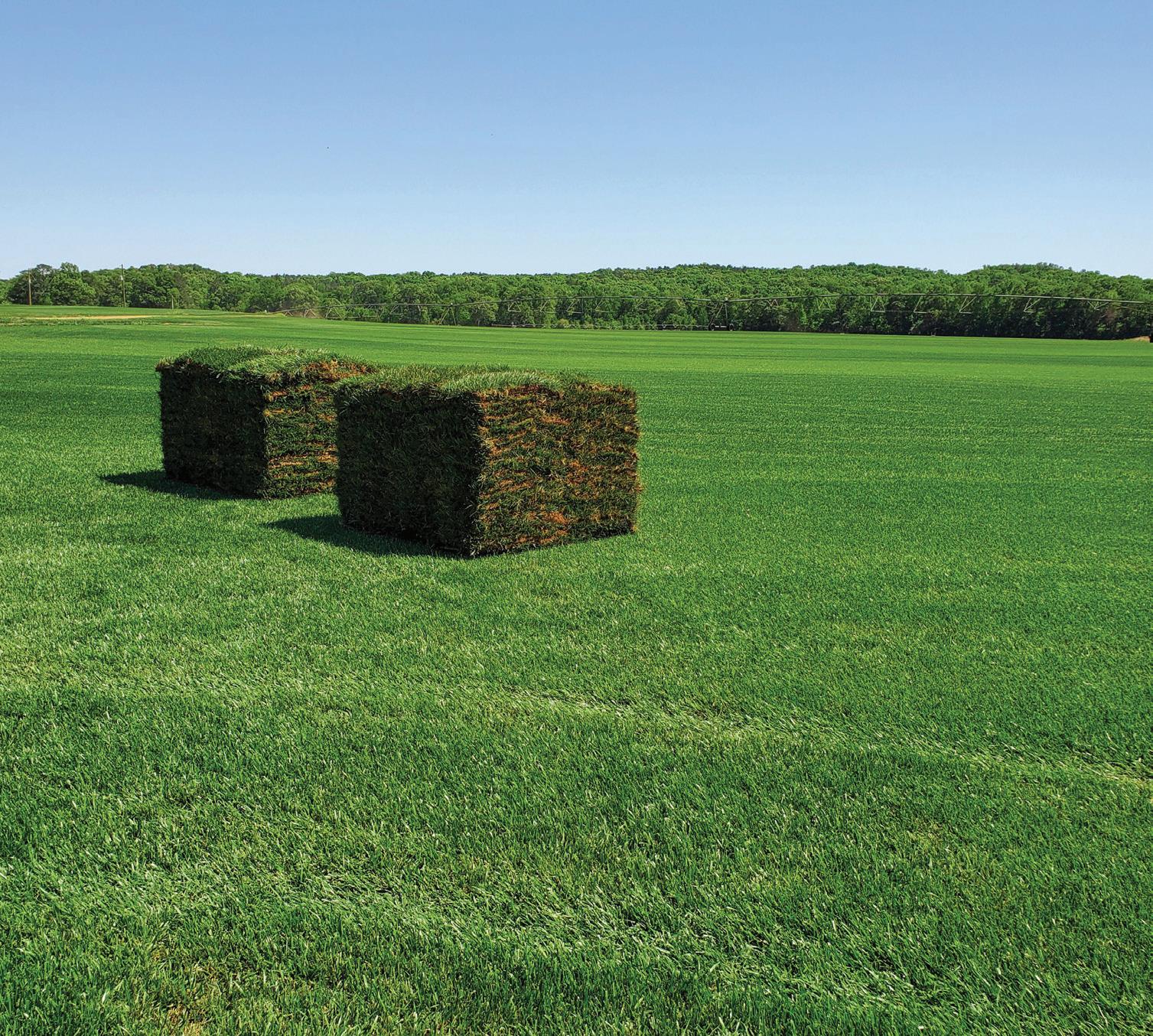

WINTER 2023 | 3 Convenient Delivery, including Monday AM Cut-to-Order and Harvested Year Round Visit NGTURF.COM Our Pro Online Store available 24/7. Call 770-431-1343 for more Farm, Fresh Sod information PARTNERS YOUR PREMIUM SOD Our Certified Turfgrass Professionals are ready with sod solutions for every job. * ™ ngturf.com • 770-431-1347 10+ VARIETIES INCLUDING: FESCUE *See Website for Details
UAC Magazine
Official publication of the Georgia Urban Agriculture Council
Board of Directors
Pam Dooley
Plants Creative Landscapes
Jennifer Jorge King Green
Matt Lowe
Swift Straw
Josh Morrow
Athletic Fields, Inc.
Ken Morrow
The Turfgrass Group
Bob Scott
Irrigation Consultant Services Steve Ware
Centennial Olympic Park/GWCC
Ray Wiedman
Outdoor Expressions
Ron White TurfPride
Ex Officio
Bodie Pennisi
UGA Extension Horticulturist
Clint Waltz
UGA Extension Turf Agronomist
Staff
Mary Kay Woodworth
Executive Director
Kathy Johnson
Marketing Director & Editor
A member of:
American Hort
Atlanta Botanical Garden
Federation of Employers & Workers of America
Georgia Arborist Association
Georgia Association of Water Professionals
Georgia Tree Council
Georgia Water Alliance
National Association of Landscape Professionals
National Initiative for Consumer Horticulture
Nursery & Landscape Association Executives
RISE (Responsible Industry for a Sound Environment)
Seasonal Employment Alliance
Tolar Capitol Partners
Georgia Urban Ag Council
PO Box 3400 | Duluth GA 30096
Phone: 706.750.0350
Fax: 404.900.9194
Email: office@georgiauac.com Web: urbanagcouncil.com
All contents copyright 2023
URBAN AG GEORGIA COUNCIL MAGAZINE
WINTER 2023
UAC NEWS 5
Executive Director message
NALP’s 2022 Woman Leader of the Year
What did you miss? UAC Networking Dinner at Caldwell Tree
What did you miss? UAC Sporting Clays Tournament 10 2023 UAC Committee Survey Looking for a way to make a difference?
What do you need to learn? Winter 2023 webinar series
REGULAR
FEATURES
Have you met...Alan Shultz, Gralan Farms, LLC
Have you met...Greg Earle, Gralan Farms, LLC
& benefits Three common misconceptions about self-funding
Save the date
Pest 411 Managing Joro spiders in the landscape
What the tech? 8 reasons why your website is not getting traffic
Safety works Preventing slips, trips and falls
Directory of advertisers BUSINESS

Food for thought Harnessing your brain for good at work
The Agronomist Reviewing the year’s successes and failures
Robust but flexible How to tune up your marketing during the “off season”
Selling your business? Developing a successful exit strategy, part 2
INDUSTRY
High school landscape competitions SkillsUSA
Georgia politics Lots of new in 2022
2023 Farm Bill primer Everything you need to know about the Farm Bill
URBAN AG Planning for spring planting: new and award winning plants
2022 Classic City Awards UGA Trial Gardens announce results
AAS trial results All-American Selections winners for 2023 season
Mini Me Watermelon Magical new coleus for 2023
Adding a vertical dimension Upside ornamental sweet potatoes
Lawn herbicide tolerance Avoid doing more harm than good
Guidelines to avoid costly issues Planting on septic drainfields
Responsible land use Protect Georgia’s water supply
4 | UAC MAGAZINE
6
8
9
12
28
30
32
34
14
15
16 Health
17
18
22
26
58
37
38
40
42
46
48
50
52
54
56
Dear UAC Members and Supporters,
Happy New Year!
Another year is behind us, and what a fast year it was! It seems as if every one of our members I spoke to and visited with were running at 100+ miles per hour. On top of running wide open, inflation, skyrocketing fuel prices, continued supply chain issues and a looming (if not already happening) recession were challenges faced by all.
I usually share Kiplinger’s economic predictions for the new year in this letter, but at the time this magazine went to print, they were not available. What resonated with me, to share with you, are some comments from industry consultant Jeffrey Scott:
How you budget in 2023 will look much different from this year. The goldrush is over! You need a savvier approach to managing expenses and revenues. 2023 will be different. Are you ready?
Keep a fluid approach to cost adjustmentsYou can’t just plug costs into your budget and hit cruise control. You have to watch costs on-going! Be prepared to change cost assumptions monthly, or every other month, or at most every quarter.
Use value-based pricing. You can’t just push up prices non-stop. Clients will balk, in fact they already are! However, when you do raise prices, you should be raising value concurrently. To do this you must understand how clients perceive your value. Engage clients in conversations about their needs and wants. Listen for their pain points and what they appreciate about your services.
Ask your team to get L-E-A-N. Even if you can pass on cost adjustments, your profits will stagnate or go backwards in “real economic” terms. Put your teams on notice. Inform your people that the boom is over, and they have to now fight for cost and time savings in every nook and cranny. Tighten up your contract terms and your systems for collections and warranty prevention and management.
Maintain a backlog and whitespace. Be more strategic in what you grow, don’t over extend yourself. Flex your capacity between your divisions, use all your people to address peak needs without over hiring. Grow sales to existing clients. You hardly had time last year; this year become experts at upselling and cross selling.

Don’t forget to recover replacement costs. Savvy budgeters recover all their equipment replacement costs in their pricing. Engage your team and engage your clients. The more they are engaged and on board, the better chances of winning in 2023.”
You can subscribe to Jeffrey Scott’s Growth Tips here: jeffreyscott.biz/growth-tips-and-9-proven-profitstrategies/
We look forward to seeing our members and engaging in person many times in 2023! We’ll kick off the new year on January 31 with a networking event at Tucker Brewing Company. February will bring us back to a favorite location, Magnolia Hall at Piedmont Park, for a networking/education dinner – stay tuned for topic and speaker! April 11 will be our annual spring event at Topiary Courtyard, followed by an industry/student dinner at Chattahoochee Tech on May 4.
Brand new for 2023: look for exciting news in the months ahead for information about a new networking/ marketing event with opportunity for vendor displays and equipment demos in late September, to be held at NG Turf’s Douglasville farm.
We are also pleased to be announce that we’ll continue our partnership with NALP in promoting workforce development through a proposed new SkillsUSA landscape competition in June at the Georgia World Congress Center. Many of our members participated in last year’s event by volunteering in the career booth and/ or donating products, landscape materials and swag. More information about this will be available in early 2023. In the meantime, read about our progress (to date) with this initiative on page 37.
We look forward to seeing you soon and thank all of you for your support through membership in UAC. Best wishes for a very successful 2023!
Kay
 | Executive Director
| Executive Director
WINTER 2023 | 5 UAC NEWS
Mary
Woodworth
1. 2.
3. 4.
5.
Meet
Pam
Dooley
NALP’s 2022 Woman Leader of the Year
Dooley says she wants to continue to develop her strong leadership team and provide the tools, training and vision to free herself up to find new opportunities.
Finding a purpose
Dooley says it took time to find their purpose, which is impacting people’s relationships with the outdoors, but since finding it they have become more focused on this goal.
Pam Dooley is a well-known figure in the industry and she was been named National Association of Landscape Professional’s 2022 Woman Leader of the Year for her innovation and desire to lead by example.
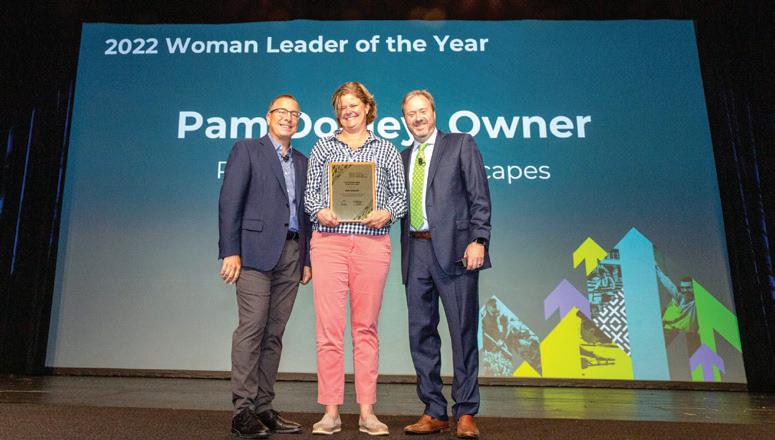
“Being a beacon for other women in the industry that are coming in and just seeing the shift and the arrival of so many women-led landscape companies, I think it’s tremendous,” Dooley says. “I think it’s a tremendous honor. I know there are a lot of other women who could very well have won this year and that is so inspiring to me.”
Dooley has been in the industry since high school, where she earned the nickname ‘Plants’ as she worked at a local garden center. She went on to study horticulture at the University of Georgia. She started her company, Plants Creative Landscapes, based in Decatur, Georgia, in 2005. Her company is relationship focused and provides residential landscape, design, construction and maintenance.
When Plants Creative first opened their Decatur office, they had around 10 employees and now they’re around 50 team members. In 2019, Dooley decided to revisit some maintenance contracts and shed customers that were no longer a good fit. While it was a hard decision, she says it’s benefited the business greatly.
Rather than focusing on size or revenue, Plants Creative is all about their purpose and promoting personal and professional development.
“We’re people first,” Dooley says. “I tell the team all the time, ‘better people, stronger professionals.’”
Dooley says over the 17 years of business, she has been able to turn visions into reality by being intentional with her time. She says she is constantly thinking about the future and paying attention to the trends both inside and outside of the industry.
One belief she lives by is Jack Welch’s saying that when the metabolism of society is faster than that of your company, that’s when you’re dead.
Over her years in the industry, she says some of the major changes have been technology, culture and the workforce. She says as the company continues to grow, they are looking for markets that align with their demographics and psychographics.
Some of Plants Creative’s recent service additions include becoming a Husqvarna Automower dealer and Hydrate, their irrigation division. She says Hydrate will be more thoughtful with how irrigation systems are designed. Dooley says both of these services are part of their efforts to become more sustainable.
“It’s not necessarily just landscapes,” Dooley says. “When I talk about impacting people and relationships in nature, there are just many ways that we can do that. That is where I see us heading is identifying opportunities that align with that purpose, and then figuring out where we take it.”
Dooley also talks weekly with a business coach, who ignites bigger opportunities to do the work. Both Dooley and her coach believe that you grow from the inside out. “You’re only as good as the effort you put in to doing the work to grow,” Dooley says.
6 | UAC MAGAZINE UAC NEWS
NALP/Philippe Nobile Photography
“For me, it has been fantastic. I have had nothing but acceptance and respect and equal opportunities. I’ve been welcomed into peer groups and not just welcomed but given positions to really share beliefs.”
~ Pam Dooley Owner, Plants Creative Landscapes Board member, Georgia Urban Ag Council
Enjoying the journey
As a woman in the industry, Dooley says it’s been a fantastic journey.

“For me, it has been fantastic,” Dooley says. “I have had nothing but acceptance and respect and equal opportunities. I’ve been welcomed into peer groups and not just welcomed but given positions to really share beliefs.”
Dooley acknowledges that this is the exception but makes herself available to other females in the industry as a resource and a supporter to let women know that they can do this.
“It’s exciting to see that shift in perspective that women in the industry are having and it’s getting stronger and stronger,” Dooley says.
When Dooley joined NALP’s board of directors in 2020, she was clear that the last thing she wanted to do was to be there for status only. She wanted to make an impact and has been able to do that.
This article was published in the Nov/Dec 2022 issue of NALP’s The Edge magazine. Reprinted with permission.
To read more stories from The Edge magazine, subscribe to the digital edition here: https://mailchi.mp/landscapeprofessionals/tlp-digital

WINTER 2023 | 7 UAC NEWS
WHAT DID YOU MISS?
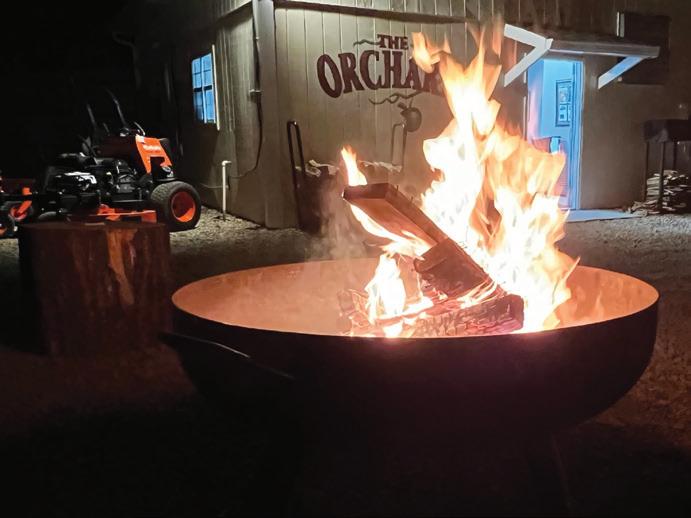

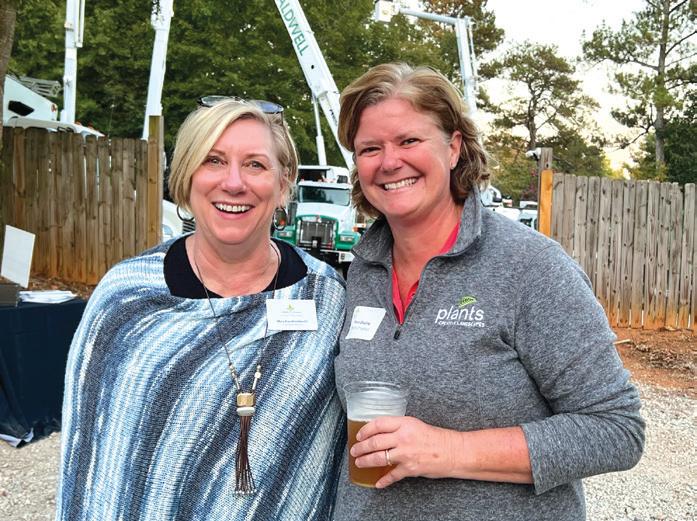
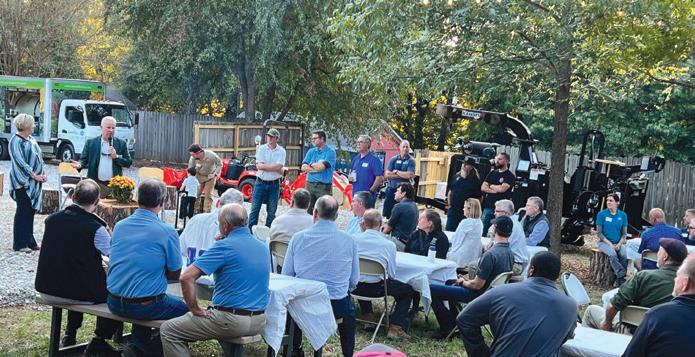
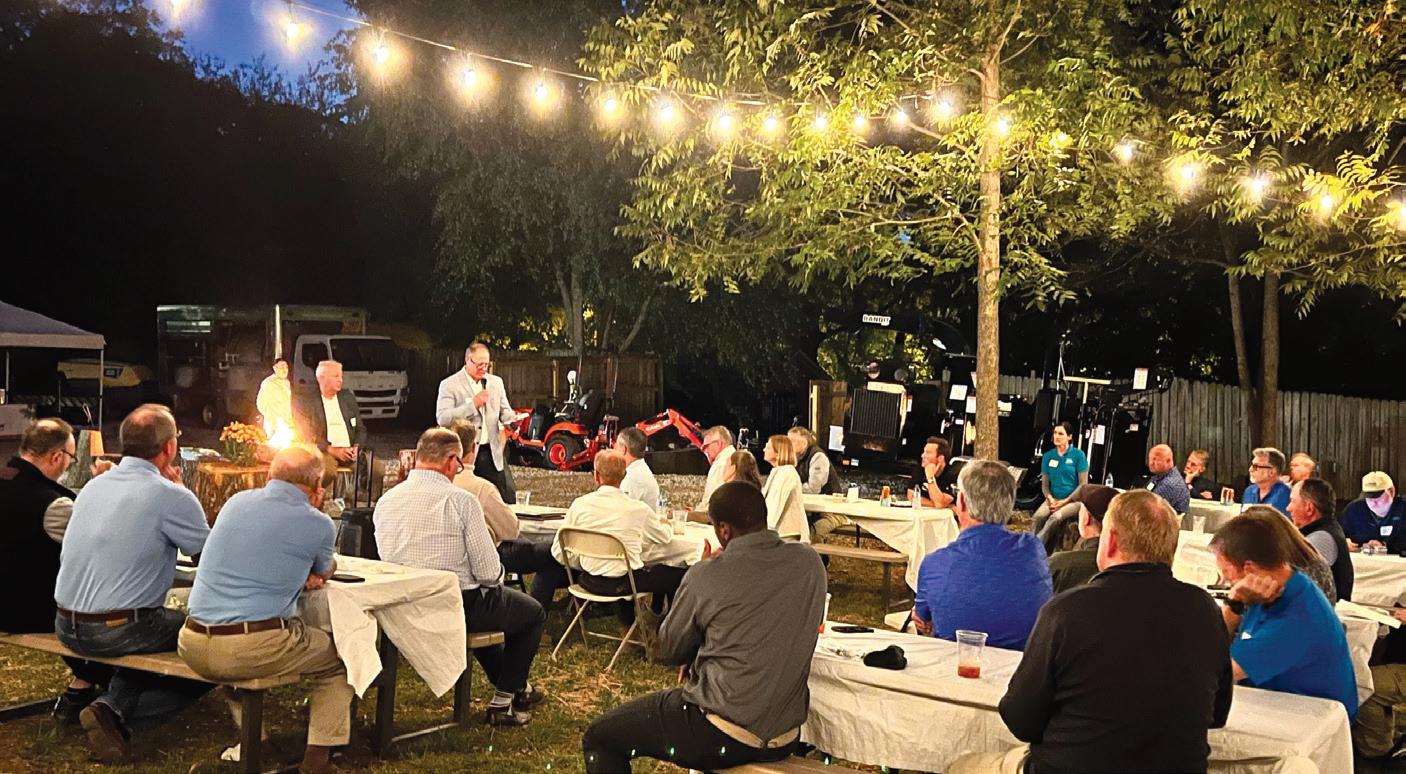
8 | UAC MAGAZINE
UAC NEWS
UAC Networking Dinner at Caldwell Tree | October 11, 2022 | Roswell GA




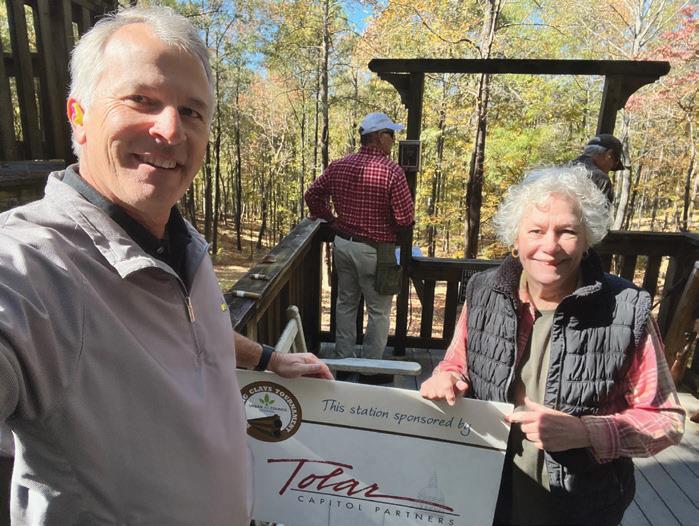

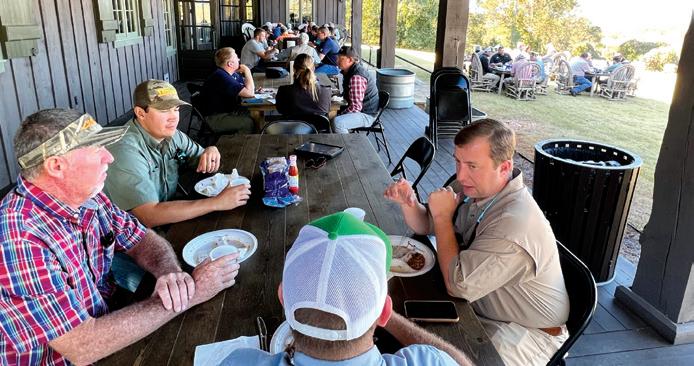

WINTER 2023 | 9
Sporting Clays Tournament | October 27, 2023 | Blalock Lakes
UAC NEWS
UAC
WHAT DID YOU MISS?
2023 UAC Committee Survey
Looking for a way to make a difference?
This survey is for current UAC members only. If you are interested in membership, please email us at office@georgiauac.com and we can assist you in joining, or visit urbanagcouncil.com to apply online!
UAC will be re-instituting committees for member participation in 2023. Which of these committees would you be interested in?
c Education/events
c Awards/recognition
c Legislative and regulatory issues
c Safety/theft
c Workforce development
What other committees would you suggest UAC add?
UAC currently has a sod producers advisory committee. We are considering additional advisory committees. Which would you be interested in?
c Landscape contractor advisory committee (includes design/build, maintenance, irrigation, hardscape, etc.)
c Vendor/supplier advisory committee
c Grower advisory committee
What other advisory committees would you suggest UAC add?
Please let us know if there are other committees, types of events or other general comments, suggestions or constructive criticism you would like to offer:
Please provide us with your contact information:
Name Company Address City State Zip Phone Email
Thank you for your thoughts and willingness to contribute your time and effort! When you’re done with this survey: Scan/Email: office@georgiauac.com | Mail: Georgia Urban Ag Council, PO Box 3400, Duluth GA 30096
Prefer to take this survey online? www.surveymonkey.com/r/2022_23Committees
10 | UAC MAGAZINE
UAC NEWS
Star Power
Tall and beautiful, this totally unique rose of Sharon makes a bold statement in the garden. Growing naturally in a narrow column, Purple Pillar® Hibiscus is a space-saving 2-3' wide and 10-16' tall, and brings real star power with vibrant purple blooms that pack each stem all summer long. Speaking of star power, Purple Pillar® Hibiscus has received the Plantarium Silver Medal and a DGA Green Thumb Award.
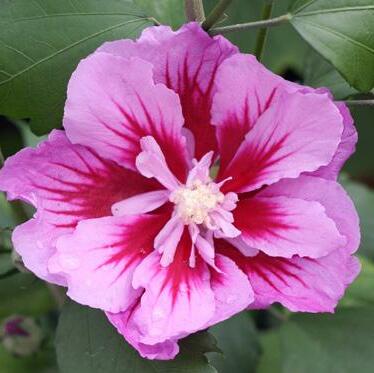

Atlanta Growers
Douglasville • 678-844-3874
Hahira Nursery Hahira • 229-794-2198
Hillside Ornamentals Byron • 478-956-0945
J & L Growers Moultrie • 229-985-1222

MNI Direct Marietta • 770-578-4599
Scottsdale Farms Alpharetta • 770-777-5875

WINTER 2023 | 11
AVAILABLE FROM THESE SUPPLIERS: www.provenwinners-shrubs.com
Purple Pillar ® Hibiscus syriacus ‘Gandini Santiago’ pp#25,568, cbr#6178; USDA zone 5-9 full sun, 10-16' tall, 2-3' wide 10’
PURPLE
PILLAR® Hibiscus syriacus 2023
What do you need to learn?
Winter 2023 Business, Landscape & Turfgrass Webinar Series
Georgia
UAC Lunch + Learn webinar sessions
focus on current industry issues, presented “live” with time for Q&A from the audience.

These events are open to both UAC members and non-members.
Advance registration is required. Upon registration, a ZOOM link will be sent for the session.
Sponsorship opportunities are available. Contact us for more info: 706-750-0350 or office@georgiauac.com
Iyus sugiharto on Unsplash
Time: 11:30 am - 12:30 pm
Credit: GA Cat 24 - 1 hour credit approved per session
Registration: UAC members: FREE if no credit needed/$10 per session to receive 1-hour GA Cat 24 credit
Non-members: $5 if no credit needed/$15 per session to receive 1-hour GA Cat 24 credit
January 6 How to Handle an EEOC
Complaint of Discrimination
Christine Green and Elijah Davis, Stanton Law, LLC
Attorneys Green and Davis will provide key information to respond to EEOC complaints, including what to expect in the investigation phase, the purpose of a Position Statement, and how to prepare for potential litigation. After attending the webinar, participants will be better prepared to spot issues as they develop in defending against a complaint. Make sure you bring your questions for an interactive Q&A at the end.
January 13 Environmental Impact and Management of Non-Native Invasive Plants
Brian Arnold, Songbird Landcare, Inc.
Non-native invasive plants have detrimental impacts upon natural areas. Learn what the impacts are, the importance of managing them, and how to do so. The presentation will address nonnative landscape ornamentals that have “escaped” into natural areas and out compete the native vegetation. Treatment options (herbicide use) will also be discussed.
January 20 Fine Tuning your Pruning Program
Rick Smith, The Pruning Guru
Organizing your tree and ornamental pruning program for maximum efficiency will help you better serve the customers, plants and the bottom line. Fertilizer, plant health troubleshooting and growth regulators will be discussed.
12 | UAC MAGAZINE
UAC NEWS
Register online now!
urbanagcouncil.com/lunch-learn
January 27
Bridging the Knowledge Gap: Science, Clients and Compliance
Greg Huber, University of Georgia
Meeting client expectations while following the science of best practices in horticulture and keeping up with a multitude of regulations can be daunting for the landscape practitioner. This session will highlight some of the most common regulatory requirements for the landscape professional and provide examples of how client expectations, regulations, and best practices in horticulture may collide. Requirements for pesticide application, (including pest and disease id and management) will be covered.
February 3 Water Management in the Landscape for Better Plant Health - From Selection to Installation and Maintenance
Dr. John Ruter, University of Georgia
In many instances, outdoor water use can be controlled and minimized with proper landscape design and plant selection. Learn how appropriate plant choices, healthy soils with appropriate grading, use of mulches, and limiting the use of high water-using plants can significantly reduce the need for supplemental irrigation. Disease and pest control will also be addressed in this session.
February 10
Identifying and Correcting Nutritional Problems in the Landscape
Dr. Bodie Pennisi, University of Georgia
This session will focus on planting depth and drainage problems, excessive pruning and crowding, pH, nutrient imbalances, PGR toxicities, herbicide drift, abiotic stresses, etc.
February 17 Armyworms and Other Emerging Pests...How to Deal with Them
Dr. Shimat Joseph, University of Georgia
Dr. Joseph will talk about the lifecycle, ecology, and seasonal occurrence of fall armyworm and other emerging pests, such as rhodesgrass mealybug or other scales. Particularly, Joseph will discuss the management options for these pests in turfgrass.
February 23 Making a big difference by taking small actions in ornamental production
Dr. Ping Yu, University of Georgia
This course is designed to identify small issues that can be easily fixed in ornamental production.
March 3 Turfgrass IPM Strategies
Paul Pugliese, University of Georgia Extension
Prevention is the most important integrated pest management (IPM) strategy for disease control, insect tolerance, and reducing weed competition. Most insects, diseases, and weeds that affect lawns can be minimized or avoided just by simply managing your grass properly. This presentation will give you the tools to maintain a healthy, stress-free turfgrass with improved pest tolerance and resilience.
March 10 2023 Sod Survey and Get Ready for Spring Green-Up
Dr. Clint Waltz, University of Georgia
March 17 Slainte (Cheers) in the Garden - Seasonal Color for the Spring
Scott Barnard, Flowerworx, LLC
WINTER 2023 | 13 UAC NEWS
Have you met...
Alan Shultz
Gralan Farms, LLC
My first job in the green industry was...mowing lawns when I was 13 years old.
My biggest challenge in my career has been…the economic downturn of 2008.
The people who have most influenced my career are…..my father, and the Pike family (for giving a young guy a chance).
My biggest career success so far has been…. still enjoying what I do.
If I had it to do over again, I would…..have researched Bitcoin a lot more when I first heard about it, and hopefully bought some.
The thing I like most about my career is…..that every day is different, and presents its own set of challenges. I also really enjoy watching plants grow.
My least favorite part of my job is…August.
If I could change careers, just for a month, I would… run my own diner.
One thing that really annoys me is…sensationalized weather forecasts.
When I’m not working, I like to…fish.
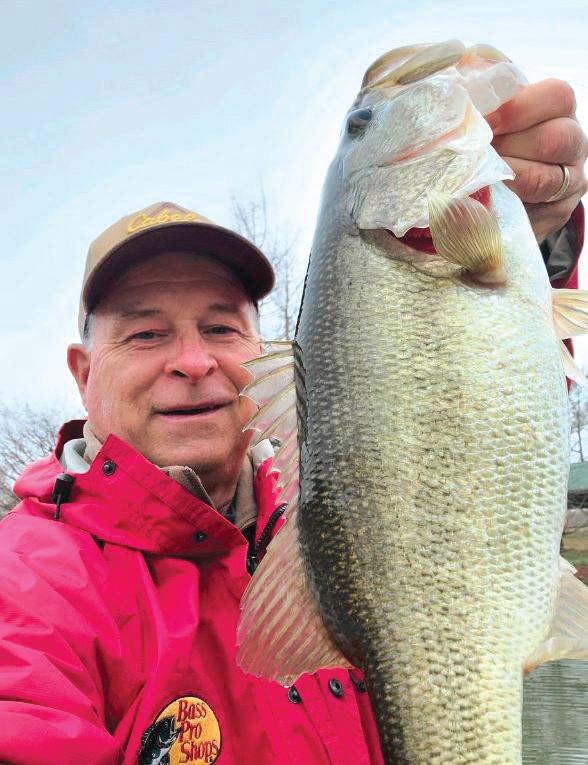
One thing most people don’t know about me is… I coach volleyball for Morgan County Schools.
Greg and Alan have been working together since the early ‘90s, both leaving Pike Nurseries to form a landscape company while starting Gralan Farms tree farm, which they transitioned to full-time in 1995.
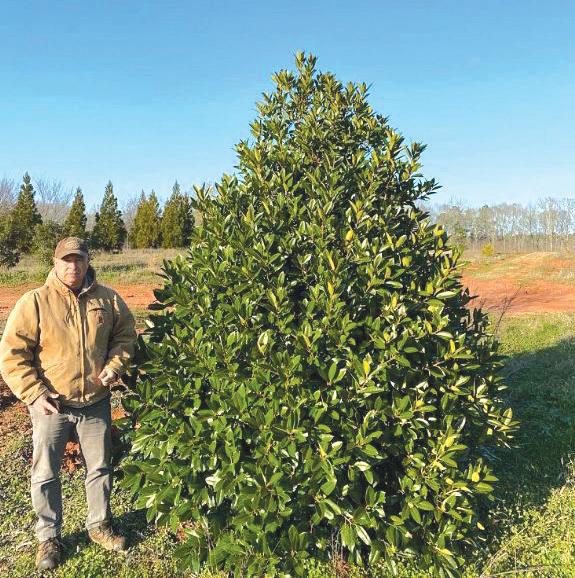

14 | UAC MAGAZINE
HAVE YOU MET
My first job in the green industry was...Pike Family Nurseries.
My biggest challenge in my career has been… surviving...:)
If I had it to do over again, I would…..do it better!
The thing I like most about my career is….. working in the great outdoors and the people I work with.

My least favorite part of my job is…unexpected problems and cold rainy days.
One piece of advice I would give to someone entering the green industry today is…make sure you love it.
The one thing most responsible for my success is… support of others in my life.
If I could change careers, just for a month, I would…Hmmmmm.
One thing that really annoys me is…negativity.
When I’m not working, I like to…hike/backpack.
Have you met...
Greg Earle Gralan Farms, LLC

Address: 3600 Dixie Highway | Madison GA 30650
Phone: 706-215-0341 (Alan, cell) 706-215-0339 (Greg, cell)
Email: gralanfarms@gmail.com Web: www.gralanfarms.com

WINTER 2023 | 15
HAVE YOU MET
Health benefit management options

Three common misconceptions about self-funding
by Tara Byrd, CIC, Employee Benefits Consultant, Snellings Walters Insurance Agency

MISCONCEPTION 2
Self-funded plans are too risky.
The term “self-funded” can sound scary. However, the truth is you do have re-insurance behind the scenes to protect you from any catastrophic claimants. Those are things that no one can predict, so there’s insurance to buy that can protect you from that. The difference is that you have more control over your plan and have more exposure to what those costs actually are. The reality is whatever claims are on the plan will continue to be on the plan, whatever model you are in.
MISCONCEPTION 3
My company’s claims are too bad to have a self-funded plan.
Every year, employers have to make tough decisions on what health insurance plans to choose and what benefits to offer their employees. While the process is stressful, most employers are not aware of alternative solutions and have even been misinformed.
In fact, a lot of companies are not even aware that selffunding is even an option. And if they are aware, it is possible they have heard incorrect information about it. This misinformation can keep employers from exploring better and cost-effective ways to manage their health benefit plans.
Here are three common misconceptions when it comes to self-funding:
MISCONCEPTION 1
Only big companies have self-funded plans.
In the past, that was true. However, that is not accurate anymore and there are many programs out there with self-funded plans. Many carriers have created a model where the scalability to go self-funded doesn’t have to be thousands and thousands of employees anymore. So if your company has 100 or more employees, it’s actually a great opportunity to evaluate to see if it’s a good fit for you.
That doesn’t really matter. What matters more is what model protects you more in the bad years. Statistically speaking, one of every five years is a bad claims year for employers. What model is going to protect you the best in that bad year? Getting into a model that protects you and your business better for those larger claims is the most important.
If you are curious about self-funding, we would love to have a conversation with you.
About the author
Tara Byrd, CIC is an Employee Benefits Consultant with Snellings Walters.

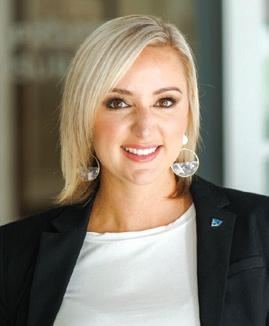
E: tbyrd@snellingswalters.com
P: 770-268-3688
W: snellingswalters.com
Snellings Walters is the official insurance partner of the Georgia Urban Ag Council.
16 | UAC MAGAZINE HEALTH & BENEFITS
URBAN AG GEORGIA COUNCIL
Gerd Altmann on Pixabay
Winter 2023 Business, Landscape & Turfgrass Webinar Series


See pages 12-13 for details!
Start off the New Year right at Tucker Brewing Company!
Beer, food, and networking with your colleagues

DATE: Tuesday, January 31
PLACE: Tucker Brewing Company | 2003 S. Bibb Drive | Tucker GA 30084
Spring Fling Dinner
DATE: Tuesday, February 28

PLACE: Piedmont Park's Magnolia Hall | Atlanta GA
Stay tuned for details!
Springtime in the Courtyard Dinner
DATE: Tuesday, April 11

PLACE: Topiary Courtyard | 3045 Jones Mill Road | Peachtree Corners GA 30071
FEB 28
APR 11
Peek into the future of your industry Meet the students, see what they're learning
DATE: Thursday, May 4



Stay tuned for details! MAY 4
PLACE: Chattahoochee Tech | 980 S Cobb Drive SE | Marietta GA 30060
NEW! Vendor/industry exhibitor and demo event
DATE: Friday, September 29
PLACE: NG Turf | Douglasville, GA
Stay tuned for details!
UAC Sporting Clays Tournament

DATE: Thursday, October 26
PLACE: Blalock Lakes | 4075 New Corinth Road | Newnan GA 30263
Stay tuned for details!
UAC Georgia Sod Producers Field Day

DATE: Tuesday, November 7
PLACE: Super-Sod | Ft. Valley GA
Stay tuned for details!
WINTER 2023 | 17 Visit urbanagcouncil.com for updates and to register. SAVE THE DATE
P esticide Credits GEORGIA approved! SEP 29
OCT 26
NOV 7
JANMAR
URBAN AG
GEORGIA COUNCIL JAN 31
URBAN AG GEORGIA COUNCIL
Asian imports spreading through Georgia
Managing Joro spiders in the landscape
by Will Hudson, Shimat V. Joseph and Jason Schmidt, Department of Entomology, University of Georgia
Fig. 1. (A) Adult female Joro spider (large spider) dorsal view and male (small spider), and (B) adult female ventral view.
The Joro spider, Trichonephila clavata, (Fig. 1) is a native of Japan and east Asia that was first documented in the US in 2014 in NE Georgia (Fig. 2). The initial population appeared to be centered around Braselton and Hoschton, GA along I-85. By 2022 the spiders had spread about 75 miles in all directions from that initial detection (Fig. 3).
The native range of these spiders in Asia extends from southeast Asia northwards through a swath of eastern China, the Korean peninsula and all but the northernmost island of Japan, and westward to India and the foothills of the Himalayas. Given that distribution, there seems to be no obstacle to the Joro eventually
expanding its range to include all of Georgia and the southeast, and most of the rest of the eastern US as well.
Description
Adult female Joro spiders are very large and colorful, with a body length that can exceed 1” (Fig. 1A). The cephalothorax is silver or white above and the abdomen is bright yellow with teal colored bands (Fig. 1A). The underside is black and white checked with red splotches near the tail end (Fig. 1A). The black and yellow banded legs are up to 3” long (Fig. 1). The egg mass is fuzzy, and off-white in color (Fig. 4A). Immature Joros are much less colorful and can be difficult to differentiate from

18 | UAC MAGAZINE PEST 411
Carly Mirabile, University of Georgia, Bugwood.org
other web spiders (Fig 4B-F), but begin to acquire their adult colors in mid-summer (Fig. 4). Females are easily recognizable by mid-August (Fig. 4G). Males are not nearly as striking as females and may not be recognized as the same species by many. They are much smaller and more slender, with drab brown, yellow and black coloration on the abdomen (Figs. 1A and 5).
Besides their size, the most striking feature of the Joro is the web. Young spiders spin silk that is clear and looks much like any other web spider silk, but as they grow the silk becomes thicker and stronger. Mature females spin silk that is yellow or golden in color and very strong and sticky. These webs may span 10’ or more with support strands that can reach >20’ and stretch between the tops of large trees (Fig. 6).
Although these are large spiders, they are also very timid. Their first response to an encounter with people is to run away and from our experiences to date, even with handling them in rough ways (removing their webs or pinching them to put in a collection vial), they do not bite.
Life cycle
Like many of our native web spiders, Joros spend the winter in the egg stage. Females deposit their eggs in the fall, in batches of several hundred to more than 1000 in silk covered egg masses that they attach to leaves, tree bark, or structures (Fig. 4A). Eggs hatch in April – May. The spiders spend the summer growing and begin to mature in August and September (Fig. 4). There is just one generation per year.
Control options
The most direct way to get rid of problematic spiders is to kill them. The manual technique of wrapping them up in the web and stepping on them is very effective. Simply destroying the web is not effective, as they rebuild in short order. Moving them to another area where they
are less problematic can work but that has to be a good distance away or they will come back. A rake, a broom, or a stick can be used for wrapping the spiders up and they all work with some limitations. The higher up the spider is, the better the chance it will end up on your head. It is probably better to ignore the ones that are more than about 10’ up and just concentrate on those that are actually in the way.
Fig. 2. Native range of Joro spider.
Fig. 3. Current spread of Joro spider in the USA.


Fig. 4. Progression of Joro spider from eggs (far left) to immatures (left to right). (A) eggs, (B) 2nd instar, (C) 3rd instar, (D) immature in mid-June, (E) early July, (F) early-August, (G) late August [Male (left) and female (right)].

WINTER 2023 | 19 PEST 411
Map from iNaturalist
Map from iNaturalist, October 5, 2022
Jena Johnson (B, C), Will Hudson (A) and Jonah Zabik (D-G), University of Georgia
A series of spray trials were conducted using readily available products bought at a local garden center. All products had “Spider” on the label as opposed to more generic “Pest” or “Insect.” The spray trials were interesting, and several products were found that are very effective at killing individual spiders including a couple that are fairly non-toxic and safe to use. Only the aerosols designed to target wasp and hornet nests have the range to reach a web up under the eaves of even a tall one-story house.
> The aerosol Black Flag Spider and Scorpion Killer (a.i. lambda-cyhalothrin 0.03% and prallethrin 0.025%) was 100% effective.
> An aerosol called Zevo Spider and Wasp spray was very effective (>97% mortality) also. The Zevo has geraniol and cinnamon oil as active ingredients and has the added benefit of smelling pretty good.
> The pre-mixed (RTU) pyrethroid (Sevin brand spray is 0.002% lambda-cyhalothrin) and Green Light Insecticidal Soap (in a manual spray bottle) were also effective (>80% mortality). Both of those products require that you spray from a foot or so away from the target, so that’s a drawback if you really don’t want to get close to the spider.
> Dawn dishwashing soap at 1% solution in water was not very effective (40% mortality).
Two or three squirts with a spray bottle are effective on small to medium spiders, but larger spiders require 5 or so. The aerosols (Black Flag and Zevo) were effective with just a brief blast.
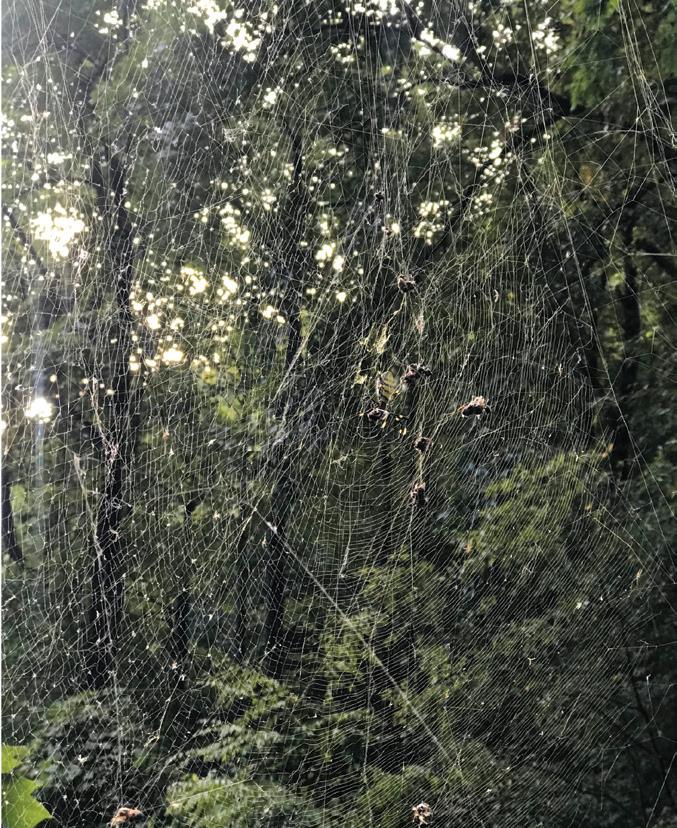

Many other homeowner products have synthetic pyrethroid insecticides as the active ingredients (cypermethrin, lambda cyhalothrin, bifenthrin, etc.) and
can be purchased as RTU or in concentrate form that the homeowner can mix in a pump-up style garden or backpack sprayer. Previous experience has shown these ingredients are all effective at killing spiders if applied directly to the target. Once dry on the substrate (leaf, wall, etc.) they are not very effective for web spiders because they do not eat or come in contact with the residues. Pyrethroids are also toxic to lots of other things besides bugs and spiders. Spraying one spider at a time minimizes the impact, but those are the same chemicals used by pest control companies to treat for mosquitoes and other bugs in the yard so if you are not comfortable with that approach then maybe that’s not the best choice.
Our recommendation for most homeowners who are somewhat tolerant of spiders is to remove and kill any spiders that set up webs on or adjacent to porches, walkways, decks and doorways (Fig. 7) - in other words, anywhere contact with the webs is inevitable. On the periphery of the yard or in shrubbery beds where people do not walk they can be left alone.
The two places where no one should allow the webs are around pollinator/flower gardens and bee hives (Fig. 8A).
20 | UAC MAGAZINE PEST 411
Fig. 6. Female Joro spider with large webbing between tree branches in open area of the forest.
Rebekah D. Wallace, University of Georgia, Bugwood.org
Fig. 5. Adult male Joro spider.
Shimat Joseph, University of Georgia
and (B) J. Zabik, University of Georgia (A) Sarah Sankehttps://www.inaturalist.org/observations/125339951,
(A) max822 https://www.inaturalist.org/observations/104623325),
Fig. 8. (A) bee caught in the Joro spider web, and (B) an immature Joro spider feeding on a scarab beetle.


WINTER 2023 | 21
Fig. 7. Joro spider web near human dwelling.
PEST 411
Of course, many professional lawn care companies offer pest control as an option. These services typically use pyrethroid insecticides (cypermethrin is common, but so is bifenthrin and several other products; the active ingredients almost always end in -thrin) that are very effective either as a spray or as a fog for mosquitoes. Remember that area wide sprays and fogging will kill (B)
Michael Echt https://www.inaturalist.org/observations/94393251
many other insects including pollinators and beneficial predators and parasites that help keep pest insects in check. Scale insects, in particular, have been shown to increase in number and damage after these treatments. Please carefully read the label of any insecticide before using.
by
There is nothing more frustrating than working on your website only to see minuscule volumes of traffic trickle in from time to time. What’s the point of having a website if there’s no traffic being directed to it?
Whether you created your business’ website or hired a professional firm, you spent time (and money) bringing it to life. So, why isn’t your website getting traffic?
Figuring out the problem can be as simple as a systematic run through a checklist of potential problems that all contribute to a competitive ranking.
In this article, we will discuss eight potential reasons on why your website might not be getting traffic and how your business can fix it. Let’s get started!
Your SEO efforts are half hearted Search engine optimization, SEO for short, is the first place you should look into when your website is not getting traffic. Take a look at your site and see how it measures up in these areas to improve your seo strategy:
If your SEO keywords are overly competitive, or just don’t match your specific products or services, it won’t attract many customers to your site.
Searches on Google and Bing are increasingly locally focused. Add the name of your city or neighborhood to your webpages to help improve your local search.
Make sure the writing on your website is searchable by search engines’ web crawlers. For instance, text in a photo file can’t be crawled by Google—same for any content in Flash.
Websites without fresh blog posts or recent updates often rank lower in search engine results. Be sure to post new, engaging web content that uses your keywords.
2.
Lack of on-site optimization
Going along with your SEO efforts, it’s very important to check your on-site optimization. What are the most important pages on your website? Are they visible and obvious to visitors? Are they visible and obvious to search engines?

Your on-site optimization can be determined by the page hierarchy, interlinking strategy, and the volume of content supporting the keyword topic in which you’re optimizing. A quick check on these items will shed some light as to what your site is and how your site has been optimized.
Include links to the most important pages near the top of your homepage. This is primarily accomplished by including those pages in the navigation bar. The fact that every page on your site will carry a link to those pages in the navigation bar signals to users and search engines that those are the most important pages on your site.
Having an internal link strategy will point to the most important pages on your site. Use varied anchor text within pages and posts to link to you the pages of high importance. This tactic is widely used by SEO consultants and experts to optimize pages within a site.
22 | UAC MAGAZINE WHAT THE TECH?
What if you threw a party and nobody came?
8 reasons why your website is not getting traffic
Tommy Le for Manta
Lordsse Design on Pixabay
1.
4 4 4 4
Thin content





Articles with a high word count are not necessarily high-quality content; however, the two can sometimes go hand-in-hand. The word count of a page that ranks highly can serve as a benchmark for how much information you need to come up with for your keyword topic.
If you have written 300 words, you can’t expect it to outrank a 3000-word page. It’s not likely to happen because the 3000-word page will have so many more topics and subtopics included, which creates a more comprehensive solution to the search query.

Pages are ranked according to how they satisfy search intent. Search engines expect certain inclusions on a page when they rank a site for a specific search query.

For example, if the search query uses long-tail keywords and phrases such as, “What is the best laptop to buy?” Then the pages that would best answer that question would be expected to have a few of the top brands listed as options (Apple, Dell, IBM, Acer, etc.).
In addition to the brands, it would be expected that there would be multiple subtopics such as battery life, screen size, warranty, etc. If a page has one title and only talks about one laptop, it would be obvious the page is promotional or severely lacking the information necessary to adequately answer the question posed in the search. These types of pages are not ranked very well based on their content.

Keyword research has been a prominent practice in creating content that is focused and inclusive of relevant subtopics. By searching your keyword, and researching the content that ranks and the related questions that surface, you can assess whether there is a gap in the content you’ve created.


You can also assess whether you need to improve the level of detail on your page. Along with these factors, it’s also important to know the user’s intent when writing the most effective content.
Load times are slow, especially on mobile Ever left a site you really wanted to visit because it took too long to load? Consumers don’t have time to wait for slow websites, especially on mobile devices. In
For more than 20 years our Atlanta Home Improvement Community has served 5000+ businesses connecting contractors and service providers with thousands of homeowners.













WINTER 2023 | 23 WHAT THE TECH?
3. Connect with our 50,000+ local digital database! 1/21/22, 2:29 PM Atlanta Best Media Mail Meet Atlanta's op 10 Outdoor Living Experts https://mail.google.com/mail/u/0/?ik=e5720a5d31&view=pt&search=all&permmsgid=msg-f%3A1742607125414016983&simpl=msg-f%3A1742607125414016983 2 Dona Halliday <dhalliday@atlantabestmedia.com> Meet Atlanta's Top 10 Outdoor Living Experts My Home Improvement Magazine <assistant@atlantabestmedia.com> ue, Aug 30, 2022 at 1:14 PM Reply-To: assistant@atlantabestmedia.com To: dhalliday@atlantabestmedia.com Follow us on Social
EVENTS PRINT & DIGITAL Sign up for your free Find a Pro Directory Listing at AtlantaHomeImprovement.com
INDUSTRY EVENT PHOTOS INCLUDE KITCHEN & BATH INFLUENCER TOUR AND DESIGN CONTEST WINNERS Print • Digital • SEO • Email • Social Media • Events • PR MY SPACE | MY STYLE | MY VISION SEWELL APPLIANCE EVERLY DESIGN COMPANY—HOME STAGING & FURNITURE LEASING, PDI–KITCHEN, BATH & LIGHTING COMPANY’S NAME AND WINNING CATEGORY BUILDER SPECIALTIES, INC ARTISAN CUSTOM CLOSETS CONSTRUCTION RESOURCES BEST COUNTERTOPS DECKS & MORE BEST DECK DESIGN/BUILD COMPANY CR FLOORING BEST CARPET SHOWROOM OF2022 After thousands of votes, we reveal the businesses chosen by you as the best of Atlanta, from kitchen and bath remodelers to heating and air, landscape design and more. Plus, 8 fabulous replaces, a master suite makeover and can’t-miss holiday home tours. CONTEST WINNERS BEST OF 2022 ISSUE ATLANTAHOMEIMPROVEMENT.COM 001_Cover-1122 Best of.indd 4.
Proud to be an Urban Ag Council member
fact, according to Google, nearly 53% of visitors will leave a mobile website if the page doesn’t load within three seconds.
There are a lot of free web tools that let you test the load time of your website. Test your site using Google’s PageSpeed Insights or Google’s site tester. Google’s site tester will tell you how mobile-friendly your site is and provide a free report on how to fix it.
You can also reduce image sizes, leverage caching, and minimize CSS and javascript to improve your page speed. While this may seem like a tall order, you can use free tools to help with all of it. The W3 Cache plugin is also a widely used tool that will speed up your site just by installing and activating.
Google will rank your site lower in search results if your site doesn’t work well on smartphones and tablets. Lower search ranking means less traffic to your website when customers search for your products or services. If you don’t have a mobile-optimized site, it’s time to make it mobile friendly!
Every keyword presents a different level of competition, so there are no set amount of backlinks that a website needs to rank for a specific term. There are other factors that come into play; it becomes a combination of those elements that will get your website moving up in the search engine result pages.
Adding more domain authority (DA) will ultimately make your website move up in the rankings. If your website has low domain authority, you will need to add more backlinks from relevant websites in order to get the needle moving.
Guest posting is an effective method for acquiring highauthority, related backlinks to your site. Guest post to blog sites related to your industry or keyword. Submit to the sites who accept articles. Make sure the sites are reputable, related to your industry, and have enough DA to have a positive impact on your own sites authority.
7.
You’ve been penalized
There are a variety of penalties that can result in your website showing up near the end of the search results and prevent it from moving closer to the top. Penalties are algorithmic, but they can also be handed through manual actions.
Having an unresponsive website
Most sites are made responsive or mobilefriendly. In fact, the first version of your site that is indexed is the mobile version. This is because most searches are performed from mobile devices.
Google has been clear about the importance of user experience which can be seen from the list of positive ranking factors that have to do with UX. A desktop version of a website on a mobile device is a pain to navigate. It could also be a reason your site isn’t getting as much traffic as it should be.
If your site isn’t made to fit mobile screens it isn’t up to the industry standard and will suffer search visibility. Responsive websites will resize images and text boxes in order to make the delivery of your content more seamless.
5. 6.
Weak backlink profile
Are you aware of what your backlink profile looks like? Do you know what links you’ve acquired and who has linked to your site? You can check your backlinks through tools such as Ahrefs and Semrush. The link profile of your website will contribute to a large portion of the ranking factors that determine your placement in the search results.
You can check whether your site has been penalized with a manual action by logging into Google Search Console. There is a tab that is labeled, “Security and Manual Actions.” Click on “Manual Actions”. If Google has penalized your site manually (which is the most severe), you will have a message informing you of the reason.
You can also check for algorithmic penalties through duplicate content and poor backlinking strategies. For duplicate content, you can run your URL through sites like Copyscape. They check any other pages that might have identical text. If your site is running on WordPress, keep in mind that posts are canonical.
If you have post snippets on your homepage that’s showing as duplicate, it’s not really an issue. WordPress will label the original post as the source which allows you to post content without penalty to your homepage.
Penalties can be triggered from linking strategies by acquiring links in any way that isn’t natural. This means all sites that offer paid links are off limits. Any “link scheme” (and there are a number of them) will trigger a penalty when Google catches on to the tactic.
24 | UAC MAGAZINE
WHAT THE TECH?
Write notes of the dates you acquire links to create a timeline that can be traced back to any drops in ranking. This way you can quickly identify the links and remove them if necessary. It’s also a good practice to monitor your link profile regularly for spammy or unnatural link patterns. (For example, high volumes of links coming from one website.) You haven’t invited people to visit your website
You might have the best website in the world, but you won’t get traffic unless you promote it. Search or display ads are one way to pay to promote your site. But we recommend starting by making sure your website and its best, freshest content are visible in a number of places online. Here
Add your website to all your social media profiles. Post links to your blog posts, news, or new product pages to attract customers to your website.

Find ways to generate links from other websites to yours. You could try:

Being quoted as a source in an article (request a link to your site).






Offering to write a guest post on influential blogs in your industry





Asking partners and like-minded businesses to add a link to your website, where appropriate, on their site or on social media.


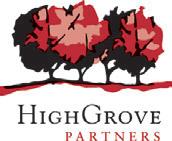
This article was originally published at manta.com. Manta is one of the largest online resources dedicated to small business. We deliver products, services and educational opportunities that are effective, easy to understand and geared to help business owners become more competitive in their respective industries. Learn more at manta.com.




WINTER 2023 | 25
Claim and create your business listings on online directories and
sites. 4 4 4 4 Thank you to all of our SEED sponsors! Gold 706.750.0350 | office@georgiauac.com | urbanagcouncil.com Diamond Platinum Contact us today to see how you can become a SEED Sponsor! Chatham Landscape Services | Crabapple Landscape Experts | Falling Leaves Lawn Care | Georgia Crop Improvement Association | Hunter Industries | The McKinley Group | Outdoor Expressions Silver Beyond the Curb Landscaping Southern States Turf Division SEED sponsorship opportunities support | energize | enable | develop SEED sponsorships offer our members an opportunity to promote their businesses and support UAC at a level beyond the membership dues. seed URBAN AG GEORGIA COUNCIL support | energize | enable | develop WHAT THE TECH? 8.
are a few additional ways in which you can promote your website:
review
4 4
UAC Safety School Preventing slips, trips and falls
The following different situations present unique slip, trip and fall hazards, so here are some tips to help control the exposures:
Housekeeping
• Keep designated walkways or paths clear of debris.
• Do not block designated emergency exits.
• Keep unused extension cords, hoses, or rope coiled up and out of the way.
• Do not place or store equipment, tools, or material on steps or landings or below ladders.
• Keep working area clean and organized.
• Immediately clean any spill and place wet floor signs out if necessary.
UAC’s Safety School provides everything you need to keep your employees informed of potential hazards. Below is the content from the Safety School training to prevent slips, trips and falls:
Objective
To point out the most common - and preventable - causes of serious injury and death related to slips, trips and falls.
Background
According to OSHA, slips, trips, and falls constitute the majority of general industry accidents. They cause 15 percent of all accidental deaths, and are second only to motor vehicles as a cause of fatalities.
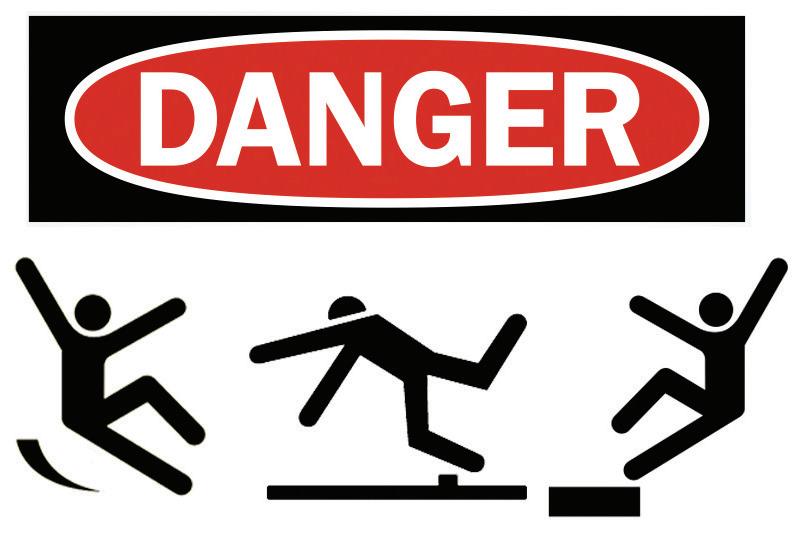
Many causes
There are many situations that may cause slips, trips, and falls: ice, wet spots, grease, polished floors, loose flooring or carpeting, uneven walking surfaces, clutter, electrical cords, open desk drawers and filing cabinets, and damaged ladder steps. The controls needed to prevent these hazards are usually obvious but too often ignored, such as keeping walkways and stairs clear of scrap and debris; coiling up extension cords, lines, and hoses when not in use; keeping electrical and other wires out of the way; wearing lug soles in icy weather; clearing parking lots, stairs, and walkways in snowy weather; and using salt/sand as needed.
• Remove frayed or loose rugs or mats.
• Install absorbent material around equipment that leaks.
Uneven walking surfaces
• Identify any change in elevation in shops with reflective tape or paint (anything greater than a ¼ inch should be clearly marked).
• Remove any trip hazards in shop such as bolts or holes in the flooring.
• Employees should wear above-the-ankle lace-up boots with a heavy lug sole when working in the field. Tennis shoes or pull-on style boots do offer the best protection for preventing slips or ankle sprains.
• Step over or around obstructions, not on them.
• Keep your hands at your sides, not in your pockets, for balance.
• Walk, don’t run - and change directions slowly.
• Pay attention to what you’re doing and where you are going.
• Look out for broken concrete, manholes, uncovered drains and similar hazards.
• Do not twist to turn when walking through ivy beds or other similar areas.
• Watch out for slippery pine straw beds or slippery slopes.
26 | UAC MAGAZINE SAVE THE DATE SAFETY WORKS
Ladders
• Never carry equipment or other material when climbing up or down a ladder. Have another employee hand them to you or use a rope to raise and lower the material.
• Always face the ladder and use a three point stance when climbing up or down.
• Never over-reach when working from a ladder. Climb down and move the ladder closer.
• Make sure ladder is on stable ground.
• Make sure your shoes and the rungs are free of mud, oil or grease.
• NEVER stand on the top two rungs.
• Have another employee hold the ladder or secure it by tying it off.
Stairs
• Keep stairs clear at all times: do not use stairs as storage areas.
• Always use the hand railing.
• Don’t carry anything that blocks your vision.
• Keep stairs free from water, oil, grease, mud or anything else that might create a slip hazard.
Dovetail ramps
• Don’t jump off. Always use a three-point contact.
• Walk slowly and avoid running.
• Avoid walking on diamond plating, unless painted with an anti-skid paint.
• Keep clear of debris and equipment if possible.
General tips to prevent slips, trips or falls:
• Stay away from the edges of loading docks, manholes, and similar places where falls could occur.
• Use a ladder, not a box or chair, to reach high places.
• Don’t jump from platforms.
• Don’t carry or push loads that block your vision.
• Identify all potential tripping and fall hazards before work starts.
• Use a salt or other similar product to prevent ice build up on walkways.
• Try to step flat footed and try not to place heel or toe down first.
FREE for all business-level UAC members!
Get this content and more in UAC’s online Safety School. Also included for each topic:
> Review points, quiz and answer key
> The companion powerpoint slide presentation
> All available in both English and Spanish
PLUS: > Attendance sheet to document training
Get the training
Visit UAC's Safety School to get training materials (training notes, slide presentation, attendance sheets) on a variety of safety topics.
UAC Safety School is available online to all businesslevel UAC members.
Here's how to access:
> Go to urbanagcouncil.com
> Use the "MEMBERSHIP" menu tab
> Click on "Members-only content"
> Log in as a member
> Use the email address and password that is associated with your UAC membership
> Need help? Contact us: Call 706.750.0350 or email office@georgiauac.com
> Scroll to the "Safety" category on that list and click on "Visit UAC Safety School"
UAC Safety School information is provided by the Georgia Urban Ag Council and Snellings Walters Insurance Agency and is intended for use by UAC member companies only.
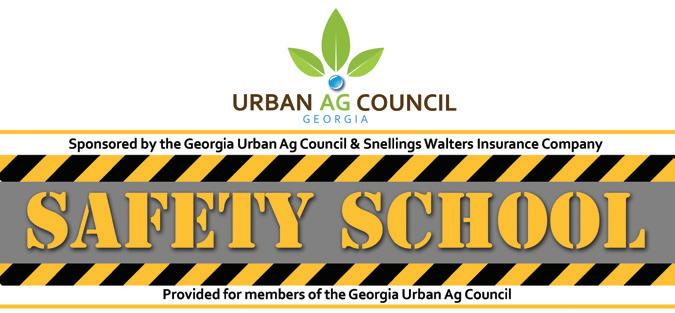
WINTER 2023 | 27 SAFETY WORKS SAVE THE DATE SAFETY WORKS
Food for thought Harnessing your brain for good at work
by Erin Saunders, Leica Geosystems
Our brains are fantastically complex organs which not only keep our body functioning, but also are constantly processing information coming to us at any given time. Many people haven’t given much thought to how the wiring in our brains impacts the decisions we make and the responses we have to internal and external pressures, but our brains, in an effort to work efficiently, are often driving behaviors we aren’t aware of.
Brains are elastic
This means that we can literally change the structure of our brains by learning new habits and responses. The brain’s ability to change is called neuroplasticity. This means that your brain can form new brain cells called neurons and it can form new connections between neurons. Both of these changes can help your brain manage challenges more effectively.
For example, when you’re burned out, doing simple things like sleeping better, listening to music, decreasing your stress, eating better, or changing your mindset can all change your brain in positive ways. Therefore neuroplasticity, your ability to change your brain, will help you perform better at work. When you know that this is possible, the specific brain changes that you can make will be that much easier.
Restructuring your brain

There are some very concrete behaviors that will impact the structure of your brain in ways that might be beneficial to you.
The first is based on a theory of a Harvard psychologist names Daniel Wegner. He found that when you’re under stress, telling yourself not to do something is not effective. In fact, it often has the opposite effect. If you tell yourself, “I will not eat cookies at work today,” then that’s exactly what you will end up doing.
Your brain doesn’t have the resources to manage your stress, move you forward, and prevent you from doing something all at the same time. So, you should frame your goals positively rather than negatively. For example, rather than saying, “I will not snack on cookies today,” you can say, “I will eat an apple when I get hungry today.”
2.
Another strategy is called affect labeling. Affect labeling is just a fancy way of saying, label your emotions. It simply means calling out any stressful or negative emotion you might be feeling.
For example, if you’re feeling stressed about the workload or number of tasks you need to get done, simply recognizing and telling yourself, “I am stressed” will calm your mind down. Leaving feelings floating freely without recognizing them keeps you feeling negatively.
By learning a little more about how our brains adapt and react to our environment, we can have better control and a deeper understanding of the decisions we make at work. 1.
Another tool that can be helpful, particularly at work, is to learn to recognize and manage contagious emotions. We’ve all had days where we’ve arrived at work in a good mood, only to come across a cranky colleague and before you know it, we’re in a bad mood too. There’s a biological reason for this based in a phenomenon called mirroring.
3.
When we’re around others, we don’t just have our own emotions in our brains. We carry their emotions too. That’s because our brains have chains of nerve cells called mirror neurons, and these neurons are wired to reflect the emotions of others.
28 | UAC MAGAZINE BUSINESS
John Hain on Pixabay
Negative emotions like fear and anger are more contagious than positive ones. Researchers believe that we register negative emotions more strongly because our brains are wired to protect us above all else. They process fear and anger more strongly in an effort to identify the source of fear or anger and protect us.
There are three things you can do to prevent someone else’s negative mood from spoiling your own.
Fist, create a dominant emotion, like happiness by looking at something that makes you happy before interacting with the cranky person. When you interact with them, keep that happy image in mind.
You can also go into the conversation by bringing up something positive. For example, “you did a great job on the project you wrapped up last week.”
Finally, you can look for positive things in the environment around the person, like a picture of a pet or cartoon, that help you reset to a happier emotion.
These techniques seem very simple, but by preparing our minds for negative interactions, we can offset mirroring them.
Sometimes our brains can get in our way when we’re in disagreement with an approach suggested by another team member. Diversity of thought on a team helps for better outcomes but can also cause some natural conflict
Many people have a negative connotation when it comes to conflict, but it can be very healthy and lead to better outcomes. Healthy conflict leverages the collective intelligence of teams, which is often stronger than the decisions of one person.
There are concrete things that can be used by teams to have healthy conflict that leads to better decisions when there is disagreement on the best path forward. One of the ways we can leverage the combined intelligence of the group is to facilitate enhanced collective intelligence
There are a few steps you can take to enhance the group’s decision-making ability.
First, collect the opinions of everyone in the group. Then develop good arguments that support your own point of view.
Next, develop good arguments that support the other differing points of view.
Considering the merits of both points of view can help us avoid the certainty bias that our own views are always the best. When you try to infer what someone else is thinking, this activates a part of the brain that is specialized for understanding others’ points of view and increases the power of the intelligence of the group. It also helps others feel heard and understood in a way that feels better and gets better outcomes for everyone.
We don’t often consider the ways in which our unconscious thoughts and reactions impact our decisionmaking, interactions, and effectiveness at work. By gaining a better understanding of how our brains work and can change, we can be more effective and productive team members and happier individuals.
About the author
Erin Saunders is Regional Human Resources Business Partner with Leica Geosystems, part of Hexagon.

P: 770.326.9517
E: erin.saunders@leica-geosystems.com

WINTER 2023 | 29 BUSINESS
4.
4 4 4 4 4 4 Tuesday, January 31 Ring in the New Year and get ready for the spring season at Tucker Brewing Company! >> Beer, food, networking with your colleagues << Register online today! urbanagcouncil.com/uac-industry-events Start off the new year right!
The Agronomist Reviewing the year’s successes and failures
by Bob Mann, National Association of Landscape Professionals
It was a long, hard season, wasn’t it? Every year it’s something: in 2021, it was armyworms eating half of the lawns in America; in 2022, for most of us, it simply did not rain. Will it be a plague of locusts in 2023? Who knows? On the one hand, the challenges we face in the green industry are formidable and difficult to overcome. On the other hand, if it were easy, we wouldn’t enjoy doing it so much.
Now that the trees are bare and the lawns are brown, it is instructive to take stock of the preceding year while it is still fresh in our minds – a debrief of sorts – with a focus on improvement for next year. Everything that transpired during the season can be broken into two categories:
> Things that worked; how can I do them better?
> Things that did not work; how can I capitalize on my mistakes?
Our task is to list those things and contemplate them so you and your business improve in the next season. To get us going, here are some examples from my past experiences:

WORKED: Focusing on prospective cancellations. When customer service representatives were given leeway to solve some issues at first contact with upset customers, many angry phone calls and emails were diffused. How might we do this better? Next season, we might start off with enhanced agronomic training
Altmann on Pixabay
for our CSRs so they can better recognize issues earlier.
WORKED: Preventive maintenance on equipment. Before hitting the road in the spring, trucks were inspected and issues such as oil changes and tuneups were done. For application equipment, those parts that frequently fail are addressed. For instance, impellers on spreaders tend to wear out with use. Swap out the worn ones before failure occurs.
DID NOT WORK: Failure to handle sales leads when they’re “hot.” In the modern sales environment, your potential customer has already done their research on both you and your competitors. The lead you get has a level of qualification that was not possible in the pre-internet age. If you do not respond immediately, you can be sure that your competitor will, and you’ll lose the sale. You may wish to dedicate one person on your sales staff who does nothing but hit these sales leads out of the park the minute they land in your inbox.
DID NOT WORK: “Wrong lawn” is a term to describe performing services at a property you do not have an agreement to service. This is also known as chemical trespass. You can and will get into a lot of trouble with both the property owner and state regulators when this happens.
30 | UAC MAGAZINE BUSINESS BUSINESS
Gerd
Geocodes in routing software are subject to the “garbage in, garbage out” rule of data. If the geocode is wrong, and the lawn specialist can’t read a map, it won’t be long until you’re getting out the checkbook to pay up. Having someone confirm the location of the property against the geocode is a good practice. Adding a photograph of the property to the customer record is also helpful. Another great idea is to include steps in your company’s procedures that ensure that the lawn specialist checks the address against the address of the house with every production stop.
DID NOT WORK: Last year, your product usage was way off base for virtually everything you applied. Aside from issues surrounding labor costs, there is nothing that will turn the black numbers on your income statement red faster than not paying attention to product usage. The old-school way of calibrating – once in the spring and forget it – will not cut it any longer. For instance, if Mr. Smith’s lawn is 4,000 square feet and what you are applying goes down at the rate of 4 pounds per thousand square feet, you need to ensure that 16 pounds – no more and no less – are applied. I call this constant calibration.

One tactic is to have the lawn specialist total up the square footage for all properties to be treated the next day, then load only the amount of product necessary to accomplish that square footage on the truck, with a small amount of extra to account for error. At the beginning of each stop, only add as much granular product to the spreader to complete that one lawn. Then, if you’re not doing this already, record exactly how much product was used at each stop. Yeah, this does take extra time, but given the cost of the products that you’re using, do you really have a choice?
About the author Bob Mann is the director of state and local government relations for NALP.
This article was published in the Nov/Dec 2022 issue of NALP’s The Edge magazine. Reprinted with permission. To read more stories from The Edge magazine, subscribe to the digital edition here: https://mailchi.mp/landscapeprofessionals/tlp-digital
WINTER 2023 | 31 BUSINESSBUSINESS
Robust but flexible
How to tune up your marketing during the “off season”
by Trip Jobe, Sales & Marketing Consultant
It’s the beginning of a new year and hopefully after some reflection on the P&L you are pleased with how 2022 turned out. But the last few months have created new headwinds and more uncertainty for 2023. How should you best address that to maximize your revenue and profit potential for 2023?
The fact that you are thinking strategically about it is a positive, vs. doing nothing or pushing off any decisions on marketing or advertising for the new year. I’ll address some ways you can think through your goals and objectives and develop a robust, yet flexible plan to drive your growth this year.
Categorize your expectations
One of the common mistakes I see are business owners who lump everything into one bucket and expect things to average out. They tell me they expect to grow 5% in sales, on the same level of spending. This doesn’t sound unreasonable until you dive into where they expect to grow that revenue. If a large portion of your customers only use a portion of your services, this can be attainable. However, if you expect to grow by entering new geographies or by mostly recruiting new customers, this growth will rarely come “free” in that first year.
A simple way to approach your resource needs is to think about this mix of growth. You can put this in a pie chart totaling 100% of your expected sales. If current customers and products make up 90-95% of your sales, then status
by ar130405 on Pixabay
quo can be reasonable. But if you always have 10-15% customer churn and want to grow new products by another 10% of your total sales, these efforts will continue to require resources to attract those customers.

Review your current programs
Are you working with a marketing company or handling this yourself? What metrics do you use to determine the health and return of your marketing investments?
Now is the time to make sure you are looking at the effectiveness of your 2022 efforts. If you are not measuring key performance indicators (KPIs), then you should take the time to determine some to track in 2023.
We refer to KPI’s as the metrics that should give you insight into the health of your business and marketing effectiveness. Vanity Metrics (VM) are metrics that can look great but don’t truly enhance your business. Many firms can help you grow social media followers, but is that generating revenue?
Here are some examples of metrics you should consider:
Cost per lead (VM) vs. cost per deal (KPI). A supplier can easily lower your cost per lead by adding more leads to your funnel, but are they worth anything? A better measure of your spending is tracking leads all the way through to deals and then track the initial costs over the deals you gain.
32 | UAC MAGAZINE BUSINESS
BUSINESS
4
Image
Awareness (VM) vs. Engagement (KPI). Many firms will tout the number of followers or visitors to your website. I’ve seen many tricks to build these numbers from contests and splashy promos. These followers often have a limited interest. Focusing on engagement metrics such as time on website or downloads of material will give you a better idea of potential engaged customers.
New customer sales ($) vs. Lifetime customer value. I won’t call new customer sales a vanity metric as there is usually real value here. It’s a quality marketing metric you want to track but it may or may not really show the long-term health of your business. By working to determine your lifetime customer value, you have a better understanding of all customers, new and existing.
Build flexibility into your plan
Big companies often promote their annual plans and have a full calendar planned and spent when the year kicks off. Sometimes in advertising and media you need to make commitments, but don’t tie yourself down. Some of the best programs and tactics our teams ever did were fairly last-minute opportunities when we had available dollars to invest. This doesn’t necessarily mean wait until you see the business landscape, but retain some flexibility in how
you spread out your budget. I’ve often held 10% of the total budget back until mid-year for these opportunities.

Set up checkpoints for the year...now
Set dates now to review your marketing performance. Let’s face it, the season will all of a sudden take off. Depending on the usual patterns, have a review planned with your team or outsourced marketing partner for March or April. Three months is an ideal review, but you may need to review sooner to make adjustments. Plan another review shortly after school is out to check in again. With these touchpoints, you can be ready to speed up or slow down your spending.
Most of these ideas aren’t complicated, they just take some advanced planning and a willingness to stick with it. You will feel more confident in your marketing investments if you take the time this off-season to put some of these plans in place. Not sure about where to start? Reach out for a brief call. Good luck in 2023!
About the author Trip Jobe is an independent sales and marketing consultant and frequent contributor to UAC Magazine P: 678-642-3933 | E: tripjobe@gmail.com
WINTER 2023 | 33 BUSINESSBUSINESS
4 4
Selling your business?
Developing a successful exit strategy, part 2
by Peter Thelen Sr., CPA, FMC, President of Thelen Financial
In part 1 of this series, we explained exactly what a business exit strategy is and we outlined why it’s important to identify your reasons for wanting to sell your business.
Your reason for selling should help inform your decision on what kind of buyer you want to attract.
It is also important to consider what your ideal future might look like after you sell your business. This will ensure that you have a clear vision for the future as you devise and implement your exit strategy.
Which exit strategy is best for you?
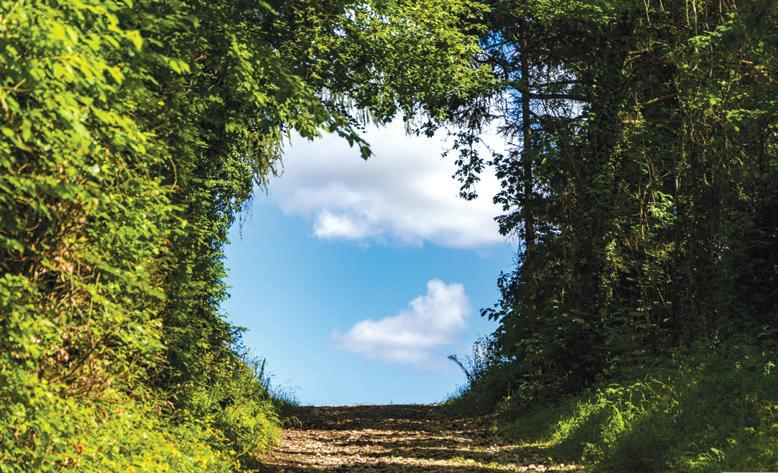
The following scenarios outline the key considerations for each type of potential buyer and the resulting outcome you may be looking for.
If you’re ready to retire and desire to leave a legacy: If you’re looking to retire and have no one to take over the business, then you’ll likely want to sell to a strategic buyer. You’ll probably want to sell the majority of your ownership, if not all of it, and have little to no involvement in the business post-sale. If you do want to stay involved, you will limit yourself to finding buyers who are willing or able to offer you the position that fits your needs post-close.
If you want to cash out, but keep working: If you’re looking for a large pay-out, then selling to a financial buyer may be the best option. These buyers are typically willing to pay a premium for businesses that fit their acquisition criteria. You’ll either sell 100% of your shares or retain a stake in the business, depending on how much cash you’re looking to get and what the buyer’s preferences are. If you end up selling to a private equity firm, they will likely require you to stay on for a transition period to ensure a successful integration.
If you want to keep the business in the family: If you have a family member or employee who is interested in taking over the business, then passing the business on through a succession plan may be the best option. This can help you ensure that the business remains
in the family, or that a key employee is rewarded for their dedication to the company. In this case, you’ll likely sell only a small portion of your stake at first and have some level of involvement in the business post-sale, whether it’s serving on the board or consulting in specific areas of the business. Outright sales are not the only way to accomplish this type of transition. You could develop an Employee Stock Ownership Plan (ESOP), for example.
If you need to free up time: If you have another business idea that you want to pursue, or if you’re just ready for a change, some form of internal succession plan would be ideal. This involves building a leadership team, and typically setting up some form of equity incentive program as well as setting up an oversight body like a board of directors. In this case you’ll likely sell off your stake over time and have a diminishing level of involvement in the business.
If you’re moving on: If you’re no longer passionate about the industry your business is in, or if you’re ready to let go of your business entirely, either a strategic or financial buyer could be the best option. Timing is key here because you are typically looking for the highest bidder and if you wait too long to sell, buyers may be less interested in your business as it will no longer be strategically important or complementary to their business. In this case, it is still vitally important to have systems and processes in place that are understandable to the buyers and can be successfully and efficiently integrated into the acquiring company.
34 | UAC MAGAZINE BUSINESS
Marcel Kessler on Pixabay
If the business is not performing and you need to be liquid: If the business is not performing well and you need to be liquid, it may be best to simply sell off the assets, both physical assets and any customer contracts or data lists. In a business liquidation, you may sell different parts of the business to different buyers or find one buyer who is willing to purchase all the assets. In any case, your company name and employees may or may not be retained by the acquiring parties.
Mastering the numbers game: Post-sale revenue and margin projections

You started your business out by crunching the numbers, backing into your sales, required margins, etc. When it comes time to sell it, numbers are even more important.
When preparing your Confidential Information Memorandum (CIM) it’s important to have a realistic view of what the business is worth. This means having a clear understanding of the revenue, margins and market conditions that exist today and what you can expect postsale.
It’s also important to remember that buyers will likely want to see proof of your revenue and margin
projections. In most sales you will also have an earn-out component or at least a working capital true-up period.
To get through these situations as painlessly as possible, you will need to make sure your numbers are good. Buyers will want to see financial statements, tax returns, and other documentation that supports your claims.
Prior to going to market, it is important to get an outside evaluation of your accounting data and processes to prepare for things like the quality of earnings due diligence as well as ensuring that your delivered working capital numbers are accurate.
The following are some important things to keep in mind when projecting your post-sale revenue and margins:
1.
Make sure your projections are realistic.
If your projections are too optimistic, buyers will be skeptical and may be less likely to make an offer. On the other hand, you don’t want to leave money on the table. You want to be confident in your numbers and the financial projections. If you hire a professional to prepare the projections, spend the time to dig deep into them and understand the methodology used to create the projections and all relevant assumptions used.
WINTER 2023 | 35 BUSINESS
Use conservative assumptions.
When in doubt, it’s always better to use conservative assumptions in your projections. This will make it more likely that your projections will be met or exceeded post-sale.
Have a plan for how you’ll achieve your projections.
Buyers will want to see that you have a clear plan for how you’ll achieve your post-sale revenue and margin projections. This means having a clear understanding of your target market, your marketing strategy, and your sales process.
Use historical data to inform your projections.
It seems like it would go without saying, but make sure you have historical data on revenue and margins to support your projections. This data can be a valuable guide in determining what you can realistically expect post-sale.
Have realistic expectations.
Remember that buyers are typically looking for businesses that they can grow and scale. This means that they’re typically not interested in businesses that are already at their peak. As such, it’s important to have realistic expectations about what your business is worth.
In addition to getting a market valuation for your business from a professional, you also need to determine what the business is worth to you. This is what’s known as your “personal valuation.”
Your personal valuation should take the following into account:
The value of your invested time.
The value of your experience.
The value of your current lifestyle.
The value of your future lifestyle.
When valuing your business, it’s important to consider your future plans. This includes your retirement plans, your plans for starting a new business, and your plans for building your legacy.
How much do you need to sell your business for in order to achieve these plans? If you’re retiring, you’ll want to ensure that you have enough money to support yourself throughout retirement. If you’re starting a new venture, you’ll need to have the capital required as well as a nest egg to fall back on if things don’t go as planned.
Depending on your plans post-close, you may need to spend time with a financial advisor, setting up trusts
or other vehicles to accomplish your goals, or if you’re starting a new business, spend time with your business advisor developing your plans for post-close activities and cashflow needs.
Typically, when your personal valuation is in line with the market value, it’s a good indication that you’re ready to sell. If your personal valuation is significantly higher than the market value, it may be an indication that it’s time to engage a business advisor to help develop a valuebuilding program to reach your numbers.
Our final thoughts on part 2 of Formulating an Exit Strategy
Having a clear idea of which exit strategy you are going to implement allows you to plot actionable steps towards getting your business ready for sale and identifying the correct buyers. Once you have a thorough understanding of the value of your business, you can begin to think about the transition process and what needs to happen for the sale to be successful, which we’ll unpack in the third part of this series.
Part 3 of Formulating an Exit Strategy will cover all of the steps you need to take to ensure a seamless transition for you, your family, and your employees. We’ll also tell you how to make sure that the strategy you implement today will see you achieving financial freedom as you move on to your next adventure.
About the author
Peter Thelen is Founder of Thelen Financial, A Georgia Urban Ag Council member.

Thelen Financial is a fullservice CPA Firm connecting real-world landscape business experience with tax planning and compliance, risk management, acquisition of capital and strategic consulting.
Thelen Financial, Inc. 107 W. Courthouse Sq. Ste 111 | Cumming GA 30040 770-527-6574 | pthelen@thelenfinancial.com
If you’re interested in selling your business or want to gain insight into the succession plan process, contact Thelen Financial today to schedule a consultation. We’ll assess your situation and help you determine the best course of action for your unique needs, giving you expert advice on how to formulate and implement a successful exit strategy so you can take actionable steps to financial freedom.
36 | UAC MAGAZINE BUSINESS
2. 3. 4.
4 4 4 4
5.
High school landscape competition NALP Foundation and UAC partner with SkillsUSA

In June 2022, the NALP Foundation held a demonstration for a high school landscape competition and showcased careers in the landscape and lawn care industry to more than 12,000 students and educators at the SkillsUSA National Leadership & Skills Conference (NSLC) in Atlanta, GA.
UAC Executive Director Mary Kay Woodworth, NALP Foundation’s Jenn Myers and Pamela Moore, and Oklahoma horticulture instructor Kara Murphy teamed up to present the inaugural National Skills USA Landscape Competition and Careers Booth at the Georgia World Congress Center.
There was tremendous interest from educators, state directors and students. Along with a written test component (general horticulture, landscape/turf operations, and plant care knowledge), students in the new Landscape Horticulture competition will need to demonstrate skills including plant ID (perennials, annuals, ornamental grasses, and woody plants), evaluation of client needs/scope of work, landscape design, estimating, and sales presentation.
To justify a national competition, SkillsUSA requires at least 15 states participate with their own state competition. To date, 11 states have confirmed interest in establishing a state-level competitive event. The Foundation will continue to promote the competition to the remaining states and will initiate a plan to support the 11 states committed to establishing their state competition. “The NALP Foundation is committed to this initiative and will further our efforts by supporting state competitions, educators and students”, says Jenn Myers, executive director of the NALP Foundation. She went on to say that, “SkillsUSA is a great forum to educate young people about professional careers in the landscape and lawn care industry.”
SkillsUSA National Leadership & Skills Conference will be held in Atlanta for the next four years. In 2023, the Foundation will expand its footprint at NLSC with a larger career booth and sponsorship of the Techspo lounge. If you or your organization is interested in contributing to this effort, please reach out via email to foundation@landscapeprofessionals.org.
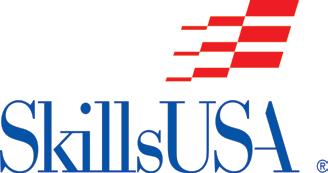
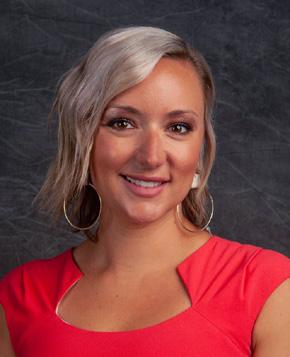
WINTER 2023 | 37 INDUSTRY
Customized Insurance for UAC Members Frustrations around high renewal increases Lack of plan understanding ICHRA and Self Funding expertise Tara Byrd, CIC Employee Benefits Consultant tbyrd@snellingswalters.com 770-508-3032 snellingswalters.com We know the green industry. Schedule a meeting with us today! Employee Benefits and Property & Casualty Services Attack your top insurance related issues to achieve better outcomes and drive down costs
Georgia politics Lots of new in 2022
 by Bryan Tolar, Tolar Capitol Partners
by Bryan Tolar, Tolar Capitol Partners
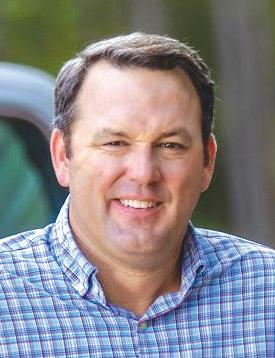
New faces and new leadership abound from the 2022 election cycle…and overall, the Georgia Urban Agriculture Council (UAC) is very pleased with the results. Serving membership interests starts with building relationships. UAC is committed to engaging with elected leaders on your behalf, but your personal relationships with those local to your community is where the rubber meets the road. Thank you to those who commit your time and financial support to build the reputation of our industry where it counts.
Our focus on protecting member interests is paramount to UAC success. We will always work to advance policy initiatives for the industry. Just like football, defense wins championships, so we do our part to manage issues that could set us back. We are present throughout the legislative session and the 2022 General Election ushered in a long list of new legislative players. Our experience matters when protecting your interests.
The November 8, 2022, election set most of Georgia’s executive and legislative stage as the 2023 session of the Georgia General Assembly begins on January 9. Here is a snapshot of the results and a preview of what’s next.
Tyler Harper will be sworn in as our new Commissioner of Agriculture and brings a lot of experience and UAC member engagement with him to his new role. Commissioner Harper has long been a friend of UAC during his decade of service in the State Senate where he chaired the Senate Natural Resources Committee and served on the Senate Agriculture Committee. His background is in row crop production, but he has taken great interest in landscape, sod, nursery and urban ag issues. He also attended UAC’s member event in June at the Red Hare Brewing Company.
Burt Jones will be the new Lieutenant Governor. His experience serving in the State Senate for ten years will bode well as he presides over the Senate Chamber. He grew up in Butts County and with his wife Jan is raising their kids in the same area. Burt has always been a friend to UAC during his service as a State Senator. We look forward to having him engage with UAC even more moving forward.
Governor Kemp earned a second four-year term as voters overwhelmingly approved of his management as the state CEO. His steady hand has benefited UAC membership. As Georgia’s economy has grown, so has the opportunity to issue tax rebates and provide lower income taxes. July through October 2022, the net tax collections in Georgia were up 7.8 percent over the same period last year. That’s $744 million in additional revenue growth - and the envy of many states across the country.
4As for the big picture on General Election results, here are a few takeaways. All but two incumbents on the November ballot secured re-election. Neither candidate received 50% of the vote in the U.S. Senate race, so Rafael Warnock and Herschel Walker are headed to a December 6 runoff. The other was Scott Hilton defeating incumbent Mary Robichaux in House District 48, near Roswell.

38 | UAC MAGAZINE INDUSTRY
There will be 42 new faces in the Georgia House of Representatives. That’s a 23.3% turnover from last year. The Republicans will still have control of the House as there are 101 Republicans and 79 Democrats.
A huge change for the House was the tragic death Speaker David Ralston in November. He was a proven leader that served all of Georgia very well during his 13 years as Speaker. The resulting leadership change places Rep. Jan Jones as the new House Speaker until the beginning of the 2023 legislative session. At that point, Rep. Jon Burns is positioned to become the next House Speaker, Rep. Jan Jones will return to serving as Speaker Pro Tem, and Rep. Chuck Efstration will be the new Majority Leader. This group will be instrumental in selecting Members to serve on committees for the 2023-2024 legislative session.

There will be 10 new Senators this year, which is a 17.8% turnover. Senate Republicans will maintain control as there are 33 Republicans and 23 Democrats. With Burt Jones as Lieutenant Governor, the Republicans selected Senator John Kennedy as the new President Pro Tem and Senator Steve Gooch as the new Majority Leader. They will be among the small group that selects new committee chairmanships and structure for the Senate committees.
Georgia Democrats will also soon be selecting leadership as the Minority in both the House and Senate. These leaders are important as we work to get support from Democrats and Republicans on issues impacting our industry.
There were also two important statewide referendum items on the November ballot. We are pleased they both passed by wide margins. Referendum A, which grants ad valorem property tax relief for those in forest management, received 2,219,303 votes (59%). This initiative was led by our friends at the Georgia Forestry Association and ultimately benefits everyone with timber property. In addition, Referendum B, which allows for property tax exemptions between farms that consolidate, passed with 2,881,483 votes (76.47%). This is a ballot initiative UAC helped pass in the 2021 legislative session. Rep. Sam Watson and Sen. Tyler Harper were instrumental in getting these on the statewide ballot. We very much appreciate their leadership and support.

Last but not least, Georgia’s stable of U.S. House Members is set. It includes 9 Republicans and 5 Democrats. New to the U.S. House are Republicans Mike Collins and Dr. Rich McCormick. With the Republicans’ recent shift from minority to majority party in the U.S. House, a whole new slate of Committee Chairmen will also come into play. Thankfully Georgia has agriculture-friendly Democrats who will continue to be helpful to our interests. Congressmen Sanford Bishop and David Scott are longtime friends and allies. The U.S. Senate will see Herschel Walker or Rafael Warnock grab the six-year term.
Elections are important and reaffirm our responsibility to engage, be present, and be informative. As the next chapter of the legislative session begins, this is a great time to seek out and connect with the elected officials in your area. Your membership and investments in UAC allow us to be a conduit for your business. We value your participation at every level. Thank you for what you do and allowing UAC to be your advocate. Together we thrive.
Tolar Capitol Partners provides background and status information on key issues, prompting action from our members when needed and lobbying on behalf of our industry. tolarcapitolpartners.com

WINTER 2023 | 39 INDUSTRY
4 4
4
2023 Farm Bill primer




Everything you need to know about the Farm Bill
by Karla Segundo Martinez, National Association of Landscape Professionals
As we get ready for the new Congress, we will need to be ready to mobilize and educate them on why policies in the Farm Bill are so important to the landscape industry and the millions of customers we serve who are also their constituents.
Here are some of the fundamentals that you need to know about the Farm Bill and its looming reauthorization in 2023.
The Farm Bill is an important development for landscape professionals because the Farm Bill is the vehicle that provides the best opportunity to amend the Federal, Insecticide, Fungicide and Rodenticide Act (FIFRA), the law that governs pesticide use.
The Path to a New Farm Bill
Each agriculture committee drafts, amends, and votes on its own version of the bill House Agriculture Committee
Each full chamber (“The Floor”) debates, amends, and votes on the bill from its respective committee
Leaders from the House and Senate, including committee chairs, form a conference committee to combine the bills
The full chambers (“The Floor”) vote on the combined final bill
Senate Agriculture Committee
The process usually begins in the year or two before current legislation expires, with stakeholders developing proposals and sharing their views at congressional listening sessions and hearings, through the media, and in direct meetings with members of the agriculture committees in both the House and Senate.
The omnibus law that began 90 years ago as crop support legislation now has an impact far beyond the farm, with programs to create wildlife habitat, address climate change and run the nation’s largest federal nutrition program.
It is a single document that is accepted in a single vote by legislature but packages together several measures into one or combine diverse subjects. Because of their larger size and scope, omnibus bills limit opportunities for debate and scrutiny.
Every five years, the Farm Bill expires and is updated. It goes through an extensive process where it is proposed, debated, and passed by Congress and is then signed into law by the President. The current Farm Bill is called the Agriculture Improvement Act of 2018 and expires in 2023.
Landscape priorities in the Farm Bill
The Farm Bill serves two distinct opportunities for the landscape industry.
First, the Farm Bill is generally one of the only pieces of legislation that move in Congress that provides an opportunity to amend FIFRA.
The final bill is sent to the White House for the President’s signature

Because of the hyper-political dynamics involved with pesticide policy seldom do we see FIFRA amendments move outside of the Farm Bill besides funding issues at the U.S. Environmental Protection Agency.
For this reason, the Farm Bill presents this unique opportunity to advocate for changes to FIFRA to better provide the landscape industry with more opportunities and access to make decisions on tools to use, manage and protect healthy green spaces.
Second, the farm bill is a terrific vehicle to pursue research initiatives that could benefit the green industry within title 12.
40 | UAC MAGAZINE INDUSTRY
1. 2.
Full House of Representatives Full Senate
2023 priorities
Pass the Pesticide Registration Improvement Act (PRIA) this Congress, OUTSIDE of the Farm Bill: It is imperative that landscape professionals support the passage of PRIA as soon as possible. We understand that negotiations are currently underway between industry and advocates, while EPA is also playing an integral role.
Preemption: Preemption at the state level is NALP’s top priority in the 2023 Farm Bill. It is important to acknowledge that when a locality is permitted to regulate pesticides, they do so on fear and emotion and not sound science. It is also important to note that the landscape industry becomes the most vulnerable to bans and restrictions when preemption is removed.
Research: NALP will be supporting efforts to expand the National Turfgrass Research Initiative by advocating for additional funding, but to also enable the funding to be accessible to the academic community to conduct research that demonstrates the benefits of turfgrass. NALP will also be supporting a provision that requires USDA to
conduct a national turfgrass survey, a process that is periodically conducted for other specialty crops but has not been conducted for turfgrass. Lastly, there will likely be a new “climate change” title in this Farm Bill and we will be looking for additional opportunities here to further demonstrate the benefits of healthy green spaces.
The National Association of Landscape Professionals (NALP) have already begun the process of presenting our 2023 Farm Bill priorities to House and Senate Agriculture Committees along with key Congressional offices. We look forward to energizing our grassroots in the coming months and will provide timely updates and action alerts through this process.

About the author



Karla Segundo Martinez is Senior Manager, Government Relations Manager, NALP-PAC, with the National Association of Landscape Professionals

WINTER 2023 | 41 INDUSTRY
4 4 4 $99 ALL ACCESS + EDUCATION UAC MEMBERS USE CODE “UAC” TO GET A SPECIAL DISCOUNT AT CHECKOUT! Connecting The Sectors Of Design + Build + Maintain • 2 Day Event With Renowned Industry Leaders • Designed For Business Owners & Decision Makers • EXPO For Products & Services That Make A Difference • Drink Reception Included! F ebruary 6–7, 2023 www.synkd.io/live-event or scan the QR code to register COBB Galleria Atlanta, Georgia
2022 Classic City Award winners UGA Trial Gardens announce results
by Amanda Budd, Writer, University of Georgia College of Agricultural and Environmental Sciences
The Trial Gardens at the University of Georgia recently announced the twelve 2022 Classic City Award winners from 400 entries this year.
Each year, Trial Gardens staff plant and evaluate ornamental plant varieties sent to them by breeders around the world.
This year, the Trial Gardens team planted trial subjects between April 15 and May 15. Over the summer, the team monitored, maintained and judged the plants from 22 companies on a variety of factors that make them desirable to gardeners.
Trial Gardens Director John Ruter explained that plant breeding companies send plants they have developed to test their growth and performance in the Georgia heat and humidity, as UGA offers a prime location for these conditions. This testing can be especially necessary when the company is from a vastly different locale.
“A lot of these companies are in different climates and need to test their plants somewhere warmer and more humid, and we’re a good place for that,” Ruter said.
In addition to the general humidity and heat associated with Georgia summers, another challenge this year was the lack of rain relative to past years.
“It was a pretty dry summer,” said Ruter. “We didn’t get any drenching rains, but the heat was also a little more manageable this year.”
Sandra Begani, manager of the Trial Gardens, noted that she evaluates the plants for uniformity, disease resistance, good leaf color and minimal or no leaf dropping. These are good signs of predictability and ease of growth, which are valuable indicators of a marketable plant.
“If all the plants look really similar, that’s a sign of predictability,” she said. “And that means it will probably be easier to predict how it will behave for consumers.”
During the trial period, Begani and garden staff record the performance indicators for each plant, which are then published bi-weekly for breeders to view. Breeders can use this information to determine if the plant will be marketable in the Southeast, if the plants are better suited for markets in a different type of climate, or if there are certain properties of the plant they should improve.
Calibrachoa Superbells® Prism™ ‘Pink Lemonade’

It is impossible not to smile when passing by this phenomenal beauty! Our visitors have regularly asked me if there are actually two different plants. This effect is fabulous and full of summer fun, and we are happy to highlight Prism™ ‘Pink Lemonade’ as one of our favorites. Perhaps there will be more in this series to come! Proven Winners
Caladium ‘Crystal Moon’
There were so many caladiums for both sun and shade at the top of our list this year, it was hard to choose the best one! The Crystal Moon is a shade variety that lights up any wooded space. This plant was also a gardeners’ favorite and was selected by our entire staff as a top plant this year! Classic Caladiums

42 | UAC MAGAZINE URBAN AG
r NEW AND AWARD WINNING PLANTS r
This new vinca hybrid is a part of the beloved Soiree collection that has wowed us for many years before. The new swirling introductions this year did not disappoint! The ‘Senorita Pink’ had the most interesting shape and healthy foliage in both moist and bone-dry locations, and is still looking as good as it did on day one. Suntory
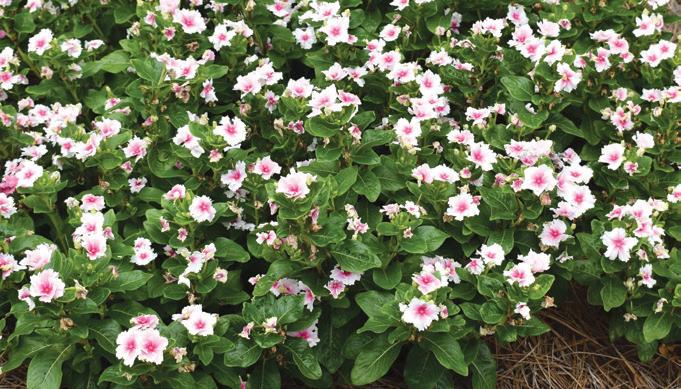
Gerbera Garvinea® ‘Sweet Sparkle’
This larger variety has surprised us with continuous blooms all summer long on flawless crowns of foliage. The flower heads are upright, and the colors are very bright and cheerful. This climate can sometimes inhibit flowering during the hottest summer months, but we have not seen any wilting or crown rot from this series of daisies. HilverdaFlorist
Heart’ This seeded coleus crop has been outstanding. The plant is made up of waves of red, heart-shaped centers and golden edges. Plants form a perfect arrangement when planted in a group. The stems are sturdy without bolting, lodging or stretching, and pruning was not required. PanAmerican Seed

Coleus
Hibiscus Hollywood™ ‘America’s Sweetheart’
We look forward to the new colors and patterns in the tropical hibiscus world each year, and J. Berry does not disappoint. This variety has been successful in both containers and in the ground. This swirling beauty is as sweet as can be! J. Berry
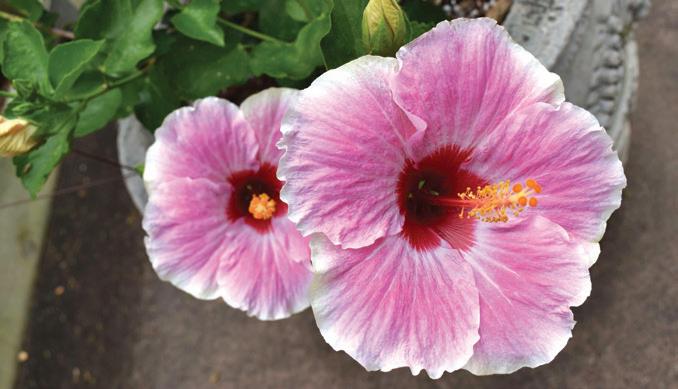
Nursery
Double Impatiens Glimmer™ ‘Appleblossom’
Our garden visitors agree that the Glimmer™ series has been outstanding in our concrete planters and hanging fiber baskets. Both locations are partially shaded and require frequent water and fertilization, but they have produced bountiful double blooms all summer long and are all disease-free. Ball FloraPlant

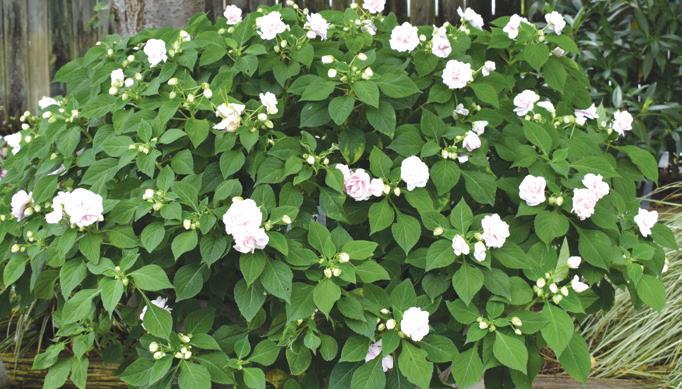
Lantana Gem™ ‘Compact Orange
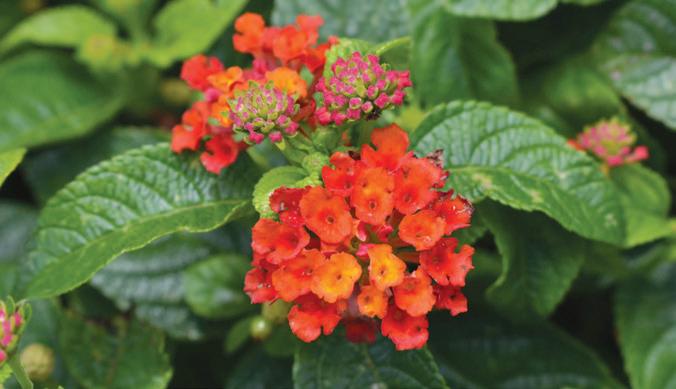
Fire’
This lantana is a necessity in the Southeastern garden for heat, drought, pollinators and deer resistance. The Gem™ series provides a unique selection of color pallets. The ‘Compact Orange Fire’ makes a very bold statement with deep red-orange clusters. Danziger Lantana
WINTER 2023 | 43 URBAN AG
Catharanthus Soiree Flamenco® ‘Senorita Pink’
Premium Sun™ ‘Ruby
MixMasters™ ‘Meant to Bee’
This combination of calibrachoa was literally meant to be grown together! Words cannot describe the color-power of these little bells, with hues that grow deeper in the center and explode with a perfect yellow star. This combination is outlasting many others and continues to shine brightly.
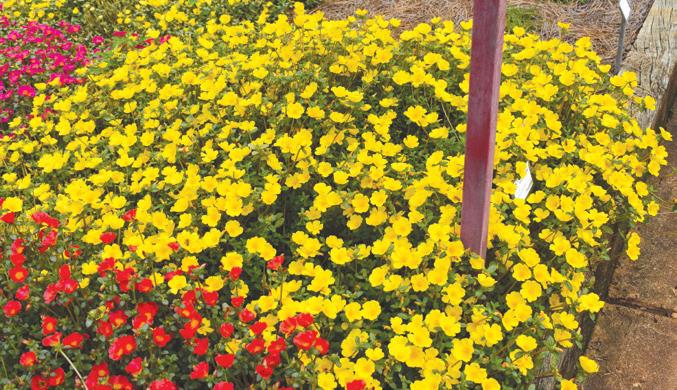 Ball FloraPlant
Ball FloraPlant
Petunia DuraBloom® ‘Electric Lilac’
The best petunia of the bunch is the ‘Electric Lilac’ from DummenOrange. Both hanging baskets and containers were overflowing with gigantic purple blooms all summer. The color intensity of these petunias is amazing! We love a petunia that lasts all through the summer here in Georgia. DummenOrange
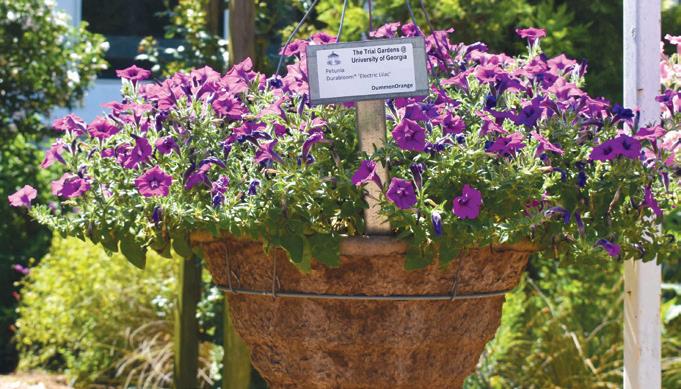

Portulaca Mojave® ‘Yellow 2023’
With so many great Portulaca entries this year, it is hard to pick a favorite, but ‘Mojave Yellow’ is special not only because of its larger flower heads and strong branching structure, but it remains open longer during the day while others have already closed before the afternoon hours. Proven Winners
Rex Begonia Jurassic Jr.™ ‘Fire Spike’
We were honored to be invited to the American Begonia Society convention this year, and we could not stop talking about this series! Once again, the shade-loving colorful foliage has blown us away. The complex foliar patterns and abundant flowers on ‘Fire Spike’ had the best performance of all in both baskets and the landscape beds. Ball Ingenuity

44 | UAC MAGAZINE URBAN AG
The easiest 5% you'll ever save. Sign up for auto-renew now! UAC business-level members can select the auto-recurring payment option for their annual membership investment and get an immediate 5% discount. The auto-recurring payment option is available for credit card payments only. Your credit card automatically will be charged on your annual renewal date. It's easy: First, go to urbanagcouncil.com > Choose the Membership menu, then Member Login. NOTE: Only the primary contact for your company will be able to manage/renew the company's membership. Contact us via phone or email if you need help with logging in.
us and
it for you!
or
Even easier: Contact
we'll do
Call 706.750.0350
email office@georgiauac.com





WINTER 2023 | 45 WWW.PROGRESSIVETURFEQUIP.COM At Progressive Turf Equipment, we continually strive to find ways to make our customers more and more productive in their fields. Our broad range of Production Mowers ensure our customers will have the right mower for their operation. Paired with Progressive’s forward thinking, our mowers are designed to keep you in the field longer and with less downtime. Visit your local Progressive dealer or our website at www.ProgressiveTurfEquip.com today to see how Progressive Turf Equipment will help you “Mow like a Champion” in any field. TD-92™ TDR-30™ TDR-26™ TDR-22™ 800.668.8873 Quality built in North America and supported by a world-wide Dealer network.
AAS trial results All-American Selections winners for 2023 season
All-America Selections (AAS) has an six new AAS Winners available for the 2023 garden season. All AAS Winners are trialed throughout North America by professional, independent, volunteer judges who grow new, never-before-sold entries next to comparisons that are considered best-in-class. Only those entries that have superior garden performance, better than the comparisons, are granted the AAS award designation.
Edible Winner
This new San Joaquin jalapeno pepper will make gardening so much easier! This is a determinate jalapeno that sets most of its fruit in a short window so there is a generous (~50 fruits per plant) number of fruits ready all at the same time. Perfect for canning, pickling and making roasted stuffed jalapenos for a crowd. But no worries if you won’t need them for a while as they hold their firmness and taste until you are ready to harvest. Judges loved the flavor of the thick-walled fruits that have just a hint of heat at 2500-6000 Scoville units. Leave them on the vine longer for a beautiful red, and still delicious, jalapeno. National Winner by Bejo Seeds
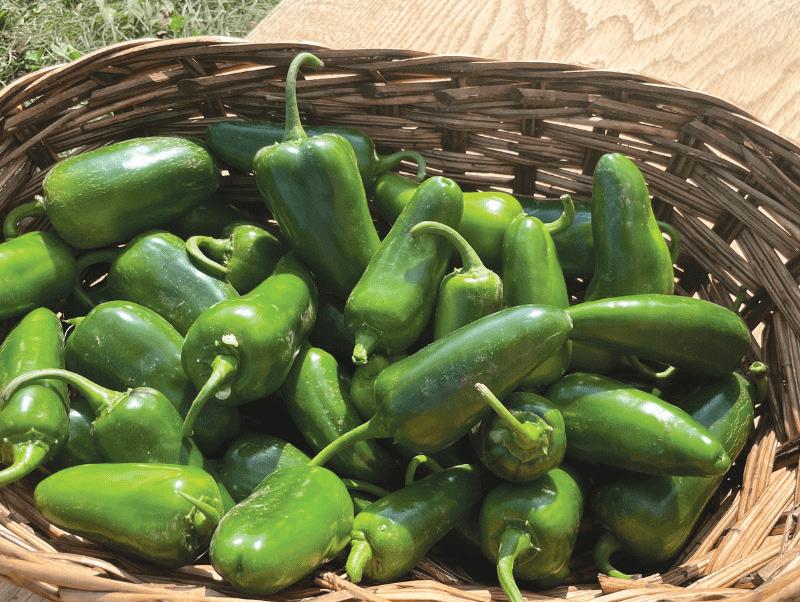
Squash kabocha Sweet Jade F1 AAS Edible Winner
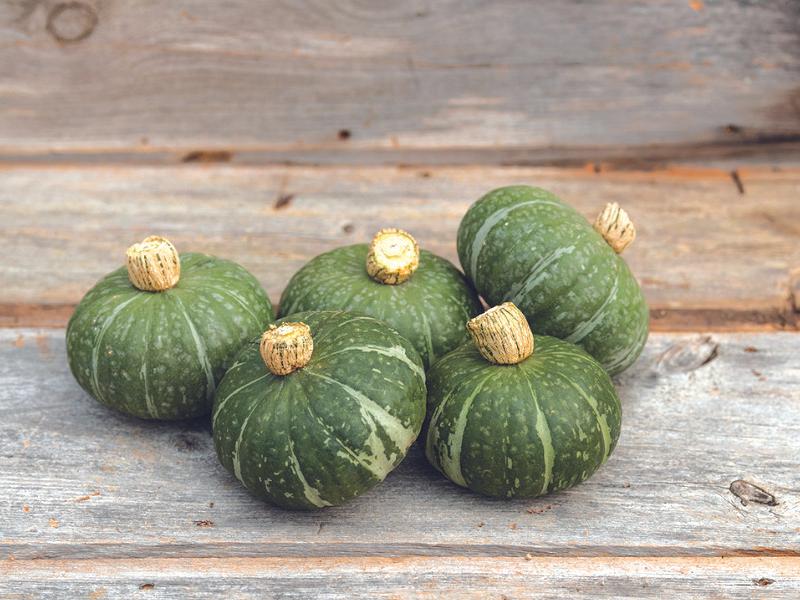
This cute, single serving sized squash is the perfect addition to your garden for a fall harvest. Sweet Jade proved itself in the AAS Trials with its high yields and good holding capability which is great news for both home gardeners and growers. Each fruit is between 1-2 pounds and can be used for single servings of squash, as an edible soup bowl or in any number of Asian-style dishes where a sweet, earthy nutritious squash is typically used. Sweet Jade’s deep orange flesh is dry yet sweet and very flavorful whether roasted, baked or pureed. Time to give this sweetie a try! National Winner by Johnny’s Selected Seeds
Snapdragon DoubleShot™ Orange Bicolor F1 AAS Seed Annual Winner
Hit me with your best shot…of double flowers! DoubleShot Snapdragon Orange Bicolor is part of a new series of intermediate height snaps perfect for the garden or as cut flowers. The stunning open-faced double flowers emerge in beautiful warm shades of orange and orange-red that transition to a dusty shade as they age. AAS Judges across the country were impressed with the strong stems that produced more branches resulting in a higher flower count. These stems produced romantic flowers all season long (even in lower light conditions) that didn’t break off in strong winds. Trialed in both the in-ground and container trial, DoubleShot will be your new go-to snapdragon. National Winner by Hem Genetics
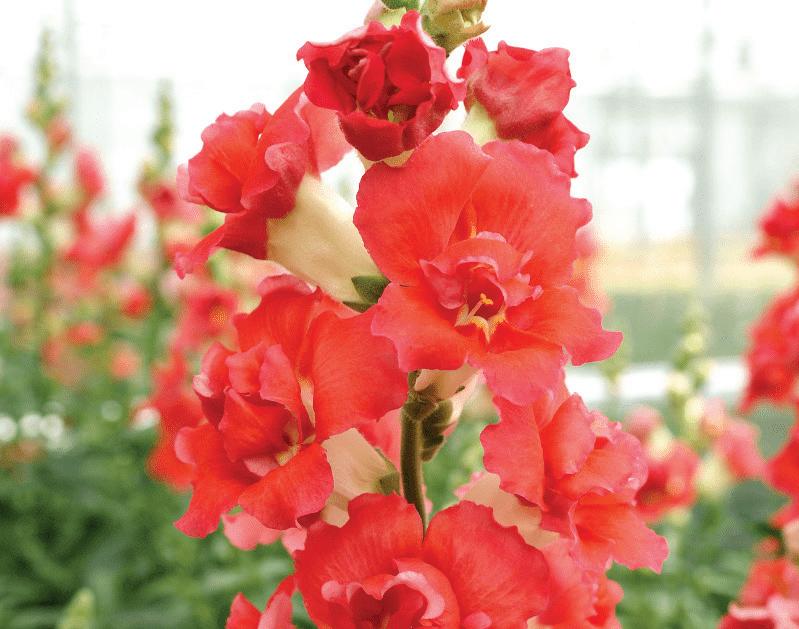
46 | UAC MAGAZINE URBAN AG
Pepper jalapeno San Joaquin F1 AAS
r NEW AND AWARD WINNING PLANTS r
Coleus Premium Sun Coral Candy
AAS Seed Annual Winner
The first seed coleus to win the coveted AAS Winner designation! Coral Candy features unique, multicolored foliage on a uniformly compact plant. This new plant form has narrow, serrated leaves that gracefully drape down the mounded plants. AAS Judges noted that this variety holds its color well, even when grown in full sun. This variety was entered into and trialed in the container trial meaning it’s perfect for small space gardens. Late in the season, it was observed that Coral Candy held up nicely in the fall and had almost no flowers even late in season. Just 3 seeds will produce enough substance to fill a 14-16” container! National Winner from PanAmerican Seed
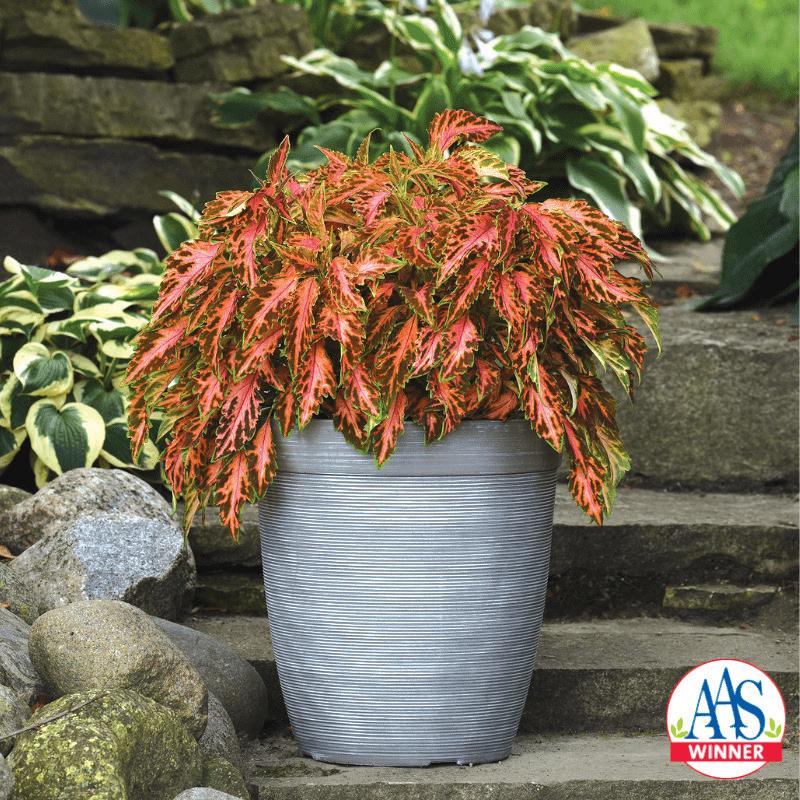
Colocasia ROYAL HAWAIIAN® Waikiki
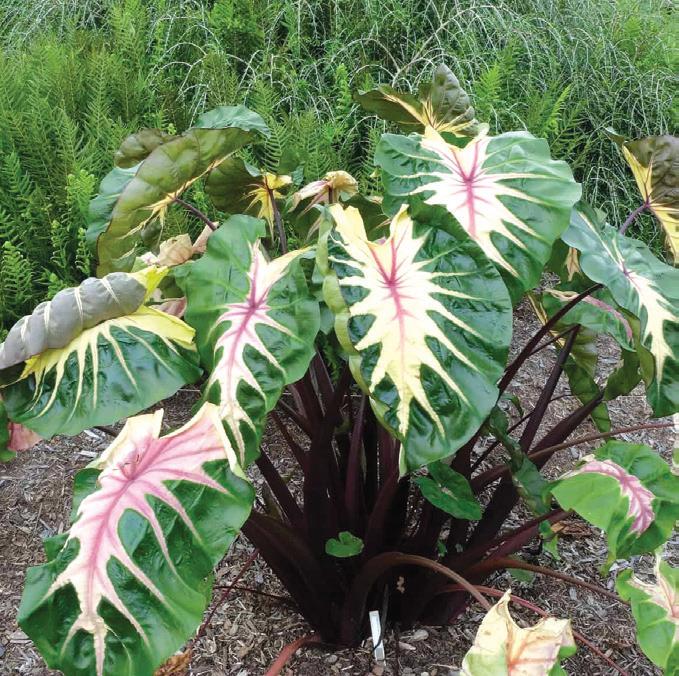
AAS
Non-Seed Annual Winner
All-America Selections has another first: A colocasia winner! Trialed in the non-seed container trial, this beauty wowed the judges with its sturdy, large glossy leaves that unfurled with a bold leaf coloration featuring pink veins and creamy white centers. Waikiki is part of the Royal Hawaiian series and produces these striking colors earlier than other variegated leaf colocasia. The deep burgundy stems produce a lush, compact plant that holds up well even in wind and rain. What a way to bring a touch of the tropics to your garden, no matter where you are located! National Winner bred by John J. Cho, University of Hawaii; licensed by Plant Haven
Tomato Zenzei F1 AAS Edible Winner

Zenzei is an early-maturing, high-yielding Roma tomato for gardeners in the Midwest. This regional winner produces a great yield of fleshy plum tomatoes that are perfect for canning and freezing. Neat and tidy plants produce fruits that are uniformly shaped and are easy to harvest on unique bushy yet indeterminate plants. The disease-resistance package on this new variety will help gardeners be even more successful than before. Each fruit has good internal flesh and fewer issues like spots and blossom end rot. Plant in full sun and provide stakes or a cage when plant reaches appropriate size but there is no need to prune! Regional Winner – Great Lakes and Heartland by Bayer Seminis Seeds
See more winners!
all-americaselections.org/winners
WINTER 2023 | 47 URBAN AG
Mini Me Watermelon Magical new coleus for 2023
by Norman Winter, Horticulturist, Author and Speaker
Just when you thought the gardening world was content and we didn’t need another new coleus, Mini Me Watermelon is rocking scorecards in university trials. Mini Me Watermelon is part of the ColorBlaze series and will be making its debut in 2023 and climbing the musthave plants chart.
Photos of trial plants at Mississippi State University’s Truck Crops Branch Experiment in Crystal Springs, MS and the University of Tennessee Gardens at the West Tennessee AgResearch and Education Center in Jackson, TN show incredible plants in full sun that - to be honestmay exceed mini.
Now perhaps mini describes the size of their leaves and that would be just perfect. These small colorful leaves, described as watermelon to coral-colored with chartreuse accents, are absolutely stunning. I would add that as the sun shifts during the day and light gets filtered the color looks more of a royal burgundy with the chartreuse. But as soon as the sun returns, it’s flaming again.
The designation of mini might have been directed to the height, which is tagged at 20 inches with an 18-inch spread. Now I did not go out and measure those in Mississippi and Tennessee but I did measure my plants and they were 34 inches on September 12. That didn’t bother me in the slightest. My ColorBlaze Lime Time coleus out front, which was supposed to reach 34 inches, grew to 42 and I pinched it all summer. I was deliriously happy about that too!
Everything flourished in West Georgia in 2022. In July we thought we would perish with the nonstop triple digit heat index numbers. Then in August and September it was, “Lord, we thank you for our daily rain.” Everything was much larger than usual. Consequently, plant partnerships or combinations had an exaggerated look.
Everyone thinks of coleus combinations in containers and ColorBlaze Mini Me Watermelon already has its share of prized recipes on the Proven Winners website. They deserve great partnerships in the landscape too! At the Young’s Plant Farm Spring Trials, they had

At the Young’s Plant Farm Spring Trials in Auburn AL,
ColorBlaze Mini Me Watermelon was partnered with Luscious Lemon Tart lantana, and Illusion Emerald Lace sweet potato for a dazzling partnership.
ColorBlaze Mini Me Watermelon coleus pairs beautifully with Limelight Prime hydrangea, Rockin’ Playin’ the Blues salvia and Color Coded, One in a Melon coneflower.

48 | UAC MAGAZINE URBAN AG
r NEW AND AWARD WINNING PLANTS r
ColorBlaze Mini Me Watermelon coleus will make its debut in 2023. The leaves are small but packed with riveting color.

ColorBlaze Mini Me Watermelon combined with Luscious Lemon Tart lantana and Illusion Emerald Lace sweet potato, both of which echoed the coleus accent colors.
My combinations were a little lucky. I partnered mine with Limelight Prime hydrangea. I admit I always underestimate the summer growth they will put on. Hence, those glorious white panicle flowers intermingled with the coleus foliage.
In the overall design I have also included Rockin’ Playin’ the Blues salvia and Color Coded, One in a Melon coneflower, that will also be making its debut in 2023.
There will be 18-selections available in the ColorBlaze series in 2023. They are among the most carefree plants you can grow and worth every penny for your garden dollar. The maintenance I have already mentioned: simply pinch to maintain bushiness and structure.
I am also one to pinch off flowers if they develop before I would like. Though I grow coleus for foliage, those flowers do have some added value. In my area the first two weeks of October are usually the last days of hummingbird activity. I will often let a few coleus blooms develop in late September to offer any extra nectar that might be needed for the hummingbirds before they head to the tropics.
Here I partnered ColorBlaze Mini Me Watermelon coleus with Limelight Prime hydrangea and Rockin’ Playin’ the Blues salvia.
Limelight Prime panicle hydrangea intermingles with ColorBlaze Mini Me Watermelon coleus which will make its debut in 2023.

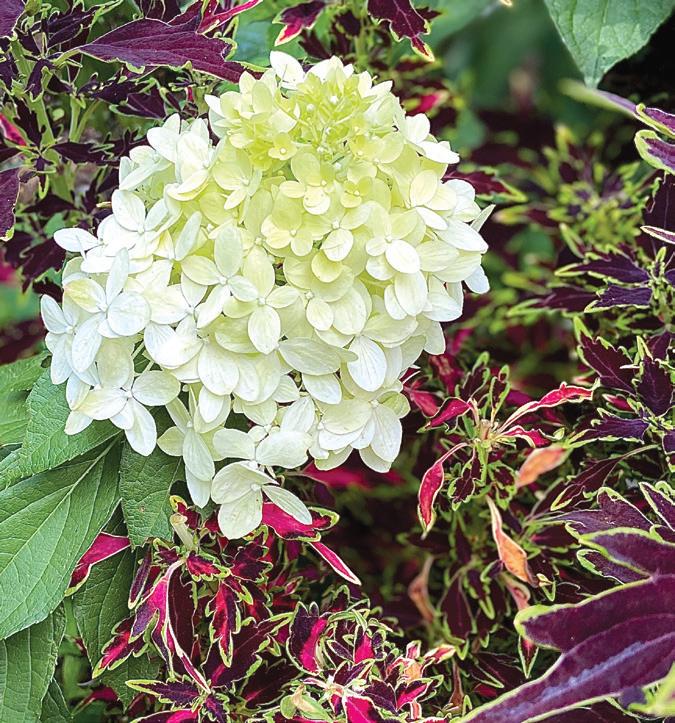
About the author
Norman Winter is an author and speaker on horticultural topics.
Follow him on Facebook for more photos and garden inspiration: Norman Winter The Garden Guy
WINTER 2023 | 49 URBAN AG
Adding a vertical dimension
Sweet Caroline Upside ornamental sweet potatoes
by Norman Winter, Horticulturist, Author and Speaker
There is a real “upside” to two new sweet potatoes making their debut in 2023. I mean that tongue-in-cheek as that is actually part of their name but their application in the landscape looks to be amazing. Here is the skinny, so to speak: Sweet Caroline Upside Key Lime and Sweet Caroline Upside Black Coffee, two climbing sweet potatoes, will be hot commodities in 2023.
My first thought was, why do we need a climbing sweet potato when they run, cascade, tumble and drape with perfection? Most of all I asked what do we do with them? So, with that thought in mind I gave my trial plants to my son, James. Oh, ye or me with little imagination!
The new Sweet Caroline Upside sweet potatoes have scored really high in trials, as in 4.79 out of 5 at Penn State Flower Trials at the Southeast Agricultural Research
& Extension Center. In Louisiana they were recognized as Blue Chip Winning plants at the LSU AgCenter Hammond Research Station.
In the Penn State trials the plants developed a shrub-like look, which was pleasant for sure. The LSU application however was *zowie*shazam* as they were allowed to climb what appears to be a steel or iron trellis.
Proven Winners suggest a potential height of 72 inches (although they might reach higher in the south) but these plants have the dual-purpose ability to both climb and run.


James planted his mixed together in a container with a copper-colored large tomato cage inverted to resemble a tower. James said he was surprised at the ability the sweet
Looking like pillars of chartreuse, Sweet Caroline Upside Key Lime ornamental sweet potatoes show why they were Blue Chip Award Winners in Louisiana.
In this container designed by Eden Estate Management in Columbus, GA an inverted large tomato cage was used to resemble a tower. Sweet Caroline Upside Black Coffee and Sweet Caroline Key Lime ornamental sweet potatoes were allowed to climb and intermingle.
50 | UAC MAGAZINE URBAN AG
r NEW AND AWARD WINNING PLANTS r
Photo courtesy of LSU Ag Center Research Station, Hammond, LA
potatoes had to climb on their own without training. Neat freaks may want to simply move or push a running stem or shoot back into the center of the structure. As the plant outgrows its tower a little snipping can certainly be done if needed.
Proven Winners has several designer recipes for each color. One of my favorites is called Morning Breeze. It features Sweet Caroline Upside Key Lime ornamental sweet potato on a small trellis as the thriller, with Truffula Pink gomphrena as a filler and Supertunia Mini Vista Pink Star petunia as a spiller. Toss in the expected butterflies and pollinators and this will be one special container.

Like all ornamental sweet potatoes, the Sweet Caroline Upside varieties like fertile, well-drained soil, and that’s especially true in the landscape. This usually means incorporating 3-4 inches of organic matter into heavier clay soil. A container with potting soil will be like a dream come true for these plants.
Plant your Sweet Caroline Upside sweet potato transplants at the same depth they are growing in the container, spacing 18-24 inches apart, using the tallest climbing support structure appropriate for your container or landscape application. Don’t forget about the possibilities with fences, gazebos, pergolas, towers, and, trellises. The potential is 6 feet, and possibly more, with a spread of 36 inches, maybe more if you wish.
These really are in the category of easy-to-grow and tough-as-nails. Even at that, plan on giving them water during those hot dry periods. These sweet potatoes grow back quickly if trimming is needed to manage its look in mixed baskets and containers or if it has outgrown its allotted structure or space.
2023 looks to be really exciting with all of the new plants. Using a climber like Sweet Caroline Upside Key Lime or Sweet Caroline Upside Black Coffee will give you a new, vertical dimension in the landscape.

Sweet Caroline Upside Black Coffee will also be making its debut. Both Upside varieties are prolific climbers with a 6-ft plus potential.
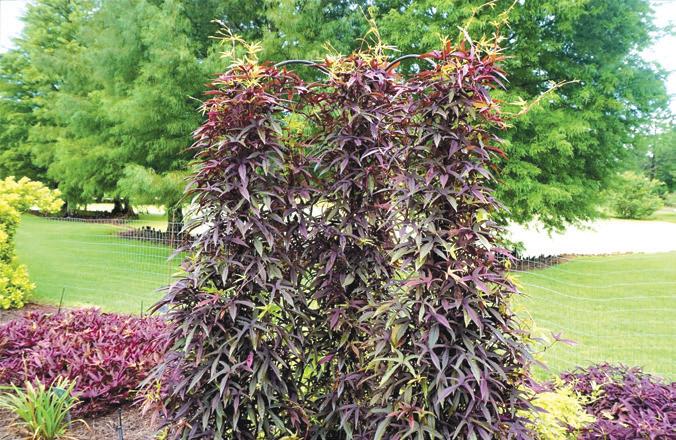
About the author
Norman Winter is an author and speaker on horticultural topics.
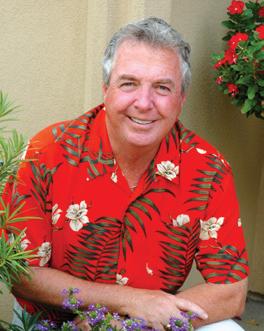
Follow him on Facebook for more photos and garden inspiration: Norman Winter The Garden Guy
Penn State developed a shrubby look with Sweet Caroline Upside Key Lime ornamental sweet potato. Upside varieties scored 4:75 and 4:79 on a scale of 5.
Proven Winners has developed a series of designer recipes for each Sweet Caroline Upside variety. This one called Morning Breeze features Sweet Caroline Key Lime ornamental sweet potato, Truffula Pink gomphrena and Supertunia Mini Vista Pink Star petunia.
WINTER 2023 | 51 URBAN AG
Photo courtesy of LSU Ag Center Research Station, Hammond, LA
Photo courtesy of The Penn State Flower Trials at the Southeast Agricultural Research & Extension Center
Lawn herbicide tolerance
by Paul J. Pugliese, Bartow County Copperative Extension
Carli Rankin
There are many options for controlling weeds in home lawns. Many of the turfgrass herbicides on the market today are highly selective and control specific weeds without damaging the grass.
However, it’s important to note that these herbicides are not completely harmless to lawns and the ability of a lawn to “tolerate” an herbicide depends on a number of factors. For example, some herbicides may actually stunt or stress the grass if it’s already struggling from a disease, drought, or winter damage.
Here are some tips to avoid potential pitfalls:
New lawns. New lawns that were recently seeded or sodded are very sensitive to herbicides. In fact, most product labels will say don’t apply within four months of planting or until the lawn is fully established. Some of the stronger formulations might even suggest waiting an entire year for a new lawn. Be sure to check the label for specific waiting intervals on new lawns.
Struggling lawns. In a healthy, vigorous lawn the impact of a pre-emergent is usually not serious, but on a lawn that is already struggling, the effect could be severe. A spring application of pre-emergent could result in the stunting of newly developed stolons and rhizomes. Areas that previously had bare spots or thinning out from disease may be slow to fill back in during the spring. Also, the stunted roots may cause the grass to turn yellow due to lack of nutrient uptake.
Split applications. In situations where the lawn is already stressed, consider using a reduced rate for pre-emergent herbicides or splitting the application and applying the other half 8 to 10 weeks later. The “less is better” approach can help extend the residual activity of a pre-emergent herbicide for a longer period of time.
Split applications also give you a chance to evaluate the lawn during spring transition in late April or May, so you can determine if the lawn is suffering from any winter injury or disease. If significant injury has occurred, you can then refrain from applying any more herbicide. If no injury has occurred, you can proceed with the follow up application.

Overlapping applications. Another common problem is overlapping an herbicide application in lawns that are oddly shaped or applying an excessive amount in small lawns. This essentially gives the lawn an “overdose” of the herbicide and may cause damage in areas that were overlapped. In many situations, a spot-spray application is sufficient for dealing with a few weeds rather than broadcast spraying the entire lawn.
Erratic weather. The erratic spring weather over the last few years has added extra stress to lawns as they emerge from winter dormancy. An early warm-up in March or April followed by a late freeze causes some lawns to go in and out of dormancy multiple times, exhausting energy reserves from the roots. Other stress factors that might be involved are low mowing height through winter or scalping during the early spring and problems with soil compaction. Each of these issues could impact the lawn’s tolerance to herbicides.
52 | UAC MAGAZINE
Avoid doing more harm than good
URBAN AG
4 4 4 4 4
Follow the label. To minimize herbicide damage to lawns, it’s important to read and follow the product label very closely. Be sure the product is labeled for you turfgrass species and carefully apply the product at the proper rate and at the proper time. Also, pay close attention to temperature extremes that are mentioned on the label to avoid herbicide injury.
Herbicide tolerance. If you choose to use lawn herbicides on a regular basis, it’s important to build and maintain a healthy lawn to tolerate herbicide use. Every few years, submit a soil test to check the pH and phosphorus levels, which are very important for root health and winter resiliency. Core aeration at the proper time might help rejuvenate a lawn and encourage a vigorous root system.
Lawn diseases. If a lawn disease has been diagnosed recently, fungicide treatments in the fall and spring can provide protection against disease spread and reduce severity, allowing the grass to recover more quickly in the spring.
Herbicide resistance. Lastly, be sure to rotate herbicides periodically to a different mode of action in order to avoid weed resistance. If you have herbicide resistant weeds growing in your lawn, there is a tendency to spray more often and use higher rates that might inadvertently affect your turfgrass.
For more information, view UGA Extension Bulletin 984, “Turfgrass Pest Control Recommendations for Professionals” available online: https://t.uga.edu/8DC

About the author Paul Pugliese is the Extension Coordinator and Agricultural & Natural Resources Agent for Bartow County Cooperative Extension, a partnership of The University of Georgia, The U.S. Department of Agriculture, and Bartow County.

For more information and free farm, lawn, or garden publications, call 1-800-Ask-UGA1 or visit our website: extension.uga.edu/publications

WINTER 2023 | 53
URBAN AG
4 4 4 4
Guidelines to avoid costly issues
Ornamental plantings on septic drainfields
by Sheri Dorn, Public Service Associate & State Master Gardener Coordinator, UGA Extension
Both woody and herbaceous plants can be used when landscaping on septic drainfields as long as a few guidelines are followed. Remember that septic drainfield lines are often very shallow, some no more than six inches from the surface. Excessive digging, rototilling or other methods of soil preparation for planting can damage these lines.
Do
Ornamental plantings can be attractive and beneficial options for the expanse of open ground designated for a septic drainfield. Properly chosen plants help manage moisture and nutrient levels in the soils around the drainfield, and can discourage activities that may cause site compaction and reduce the effectiveness of the system.
The drawback is that poor plant choices can create costly maintenance issues, and any septic drainfield repair work could disturb valued planting areas. By following a few simple guidelines, planting in these areas can be both pretty and practical.
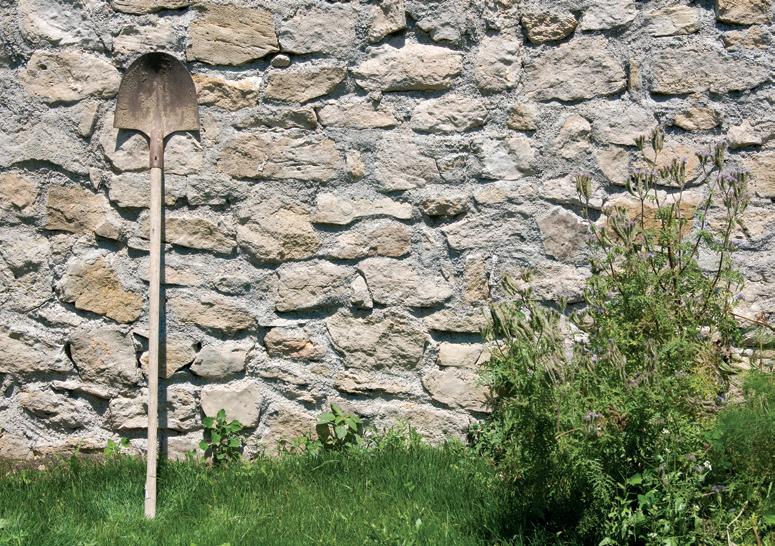
Ornamental landscape plants are broadly grouped into two categories: woody ornamentals and herbaceous ornamentals.
Woody plants are shrubs and trees whose stems persist above ground year after year. These plants usually have larger root systems and mature sizes than herbaceous plants. Roots of woody ornamentals are more likely to interfere with septic drainfields.
Herbaceous plants, on the other hand, die back to the ground during the winter and include annuals, perennials and turf. Perennials, including turf, will return the next year from their roots, but annuals will have to be planted fresh each year. These plants are usually smaller in size and their root systems tend to be shallower and less aggressive than those of woody plants.
> Do sample the soil periodically (every one to three years) to monitor soil pH and nutrient levels, correcting as necessary for plant selections. Follow the same sampling and testing procedures as for other sites (refer to UGA Cooperative Extension Circular 896, “Soil Testing for Home Lawns, Gardens, and Wildlife Food Plots,” for more details: https://extension.uga.edu/publications/ detail.html?number=C896).
> Do wear rubber gloves to protect hands and skin from any harmful organisms within the soil. Typically, the soil microbes help remove harmful pathogens; however, several site-specific factors, such as soil type, soil structure and weather, can affect this process. As a precaution, wear rubber gloves when gardening in this area. Wash the gloves in warm soapy water when finished, and allow the gloves to dry before putting them away.
> Do choose plants that will succeed with the amount of sun and moisture found on your septic drainfield. Salt tolerance is also a consideration, as soil in drainfield areas may have higher salt levels resulting from nutrients in the effluent. Some suggestions include beebalm, daylily and yarrow.
> Do choose non-aggressive plants that are unlikely to invade the drain lines. Herbaceous plants can be planted closest to the drainfield, turf can be planted over the drainfield, and shallowrooted perennials and annuals can be planted nearby. Avoid compaction, crushing or damage to the drainfield during installation.
> Do install woody plants an appropriate and safe distance from the septic drainfield. A good rule of thumb is to use the ultimate mature height of the
54 | UAC MAGAZINE
URBAN AG
selected tree as the minimum planting distance from the septic drainfield, then increase the distance. For example, if you are planting a crabapple, plant the tree at least 25 feet from the nearest drain line; 50 to 75 feet would be even better. Consider planting smaller and less aggressive cultivars, if possible.

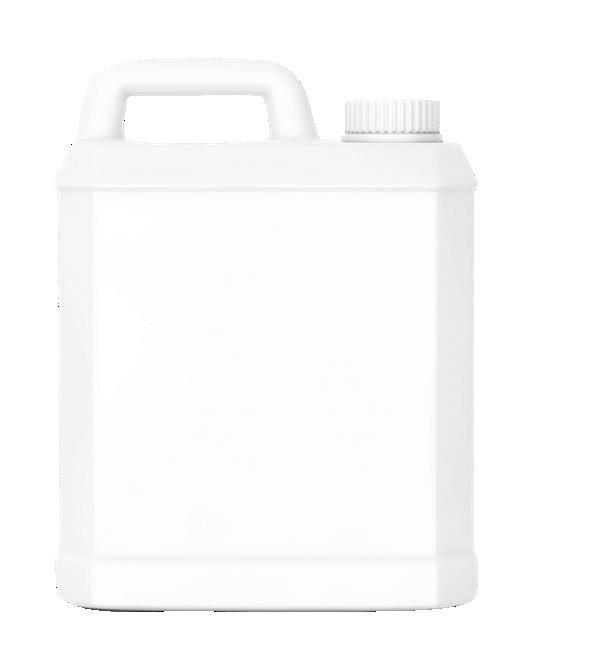
Don’t
> Don’t disturb the soil by rototilling deeply or double digging. This could damage shallow septic drain lines.
> Don’t plant vegetable gardens or other edible plants on septic drainfields. Harvestable parts of edible plants could become contaminated by soil microorganisms when planted on the drainfield. Also, the frequent cultivation associated with vegetable gardening could damage drain lines.

> Don’t choose plants that typically thrive in wet locations. Trees such as willow and birch are notorious for thriving in wet spots in the landscape, including water lines, sewer lines, septic drain lines and even wet spots along a foundation. When tree roots invade these septic drain lines, the extra moisture and nutrients favor root and plant growth, and lines become clogged and damaged.
> Don’t add soil on top of a drainfield unless it is a minimal amount to install a plant. Adding soil on top of a drainfield can negatively affect the performance of the system.
> Don’t construct raised beds on a drainfield.
> Don’t install irrigation systems in the drainfield. The additional water could reduce evaporation and drying of the soil. Only water plants as needed until they are established, and avoid frequent irrigation that will reduce soil drying.
> Don’t install groundcovers that will form dense mats and collect leaf debris. This can create cool, moist conditions that will prevent the soil from drying.
> Don’t mulch plants so thickly that soil moisture evaporation is reduced.

> Don’t install rain gardens or any other landscape feature, such as a water garden or pond, over the drainfield.
> Don’t use landscape fabrics or plastics as weed barriers; they interfere with the soil drying process.

> Don’t install hardscape elements, such as nonpermeable and semi-permeable surfaces,
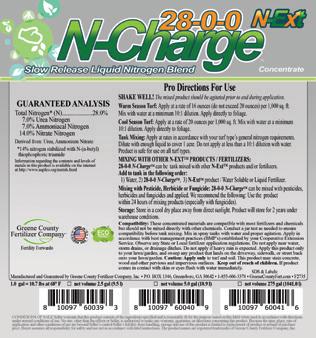


over the drainfield. Paving, pavers, decking and other surfaces will compact the drainfield, interfere with the soil drying process and may also damage drain lines.
> Don’t drive heavy vehicles on the drainfield. When installing landscape features, carry materials to the planting location to avoid soil compaction.
Trees to avoid
> Willow (Salix spp.)
> Birch (Betula spp.) > Magnolia (Magnolia spp.) > Poplar (Populus spp.) > Elms (Ulmus spp.)
> Some maples (Acer rubrum, Acer saccharinum)
When carefully chosen and placed strategically, ornamental plants can be a helpful and attractive addition to septic drainfields. Plants naturally cycle the water and nutrients from soils in a septic drainfield and their roots hold the soil in place. For best results, choose herbaceous plants with non-aggressive root systems and install woody ornamentals safe distances from drain lines.
WINTER 2023 | 55
URBAN AG GreeneCountyFert.com Corp. HQ/MFR: Greene County Fertilizer Company 1490 Airport Rd., Greensboro, GA 30642 Fertility Forward® Fertilizer MFR ▪ Distributor of Chemical L&O pest control products Our bio-based fertilizers & specialty fertility products are blended to feed plants, improve soil fertility and build topsoil. POWER UP YOUR SOIL MAXIMIZE YOUR FERTILIZER EFFICIENCY High Performance Plant Nutrients Fertilizers ▪ Specialty Products Soil Amendments ▪ Custom Blends BUY/SHIP DIRECT
Responsible land use Protect Georgia’s water quality
by Martin Wunderly, Area Water Agent, UGA Extension’s Northeast District
A vegetated riparian buffer along this pond allows for recreation access with small clearings for skiffs and kayaks. Riparian buffers work to prevent rainfall runoff from carrying fertilizer, pet waste, and driveway or street contaminants from entering nearby streams and ponds.
Natural water supplies in Georgia are valuable resources affected by weather, such as drought or flood, and land use activities, like landscape maintenance and urban growth.
While we have little control over the effects of weather, we can tailor our land management practices to better protect water quality in Georgia. Land use activity in every watershed affects local waterways on the surface and could impact groundwater below.

These recommendations from University of Georgia Cooperative Extension will protect water resources and could reduce costs of lawn maintenance and drinking water treatment.
Some of the main contributors to surface water pollution are excess nutrients, including nitrate, nitrite, ammonium, and phosphorous. While these compounds are useful for plant growth, high concentrations in local waterways are considered pollution. Excessive amounts
of these nutrients fuel algae growth that clogs ponds and lakes, then decomposes on the bottom to create low oxygen environments, harming fish populations. Plant fertilizers are full of nutrients and must be handled appropriately to protect local waterways.
Phosphorus nutrients can be limiting to algae growth in freshwater, but nitrogen levels mostly affect algae growth in saltwater. Most of our detergents no longer have phosphorus to help prevent pollution in streams and ponds, but fertilizers contain both phosphorus and nitrogen. This pollution can wash off the land via stormwater and travel downstream to the Atlantic or Gulf, causing harmful algae blooms along the way that damage aquatic ecosystems, threaten fishing and tourism businesses, and can kill people and livestock.
Managing landscapes to protect water quality should also consider plant selection, design and stormwater control. Some important fertilizer and landscaping guidelines include:
56 | UAC MAGAZINE URBAN AG
Test your soil. Find out what nutrients are present or lacking before designing a fertilizer plan.
Plant the right plants in the right place. This reduces the need for extra irrigation and fertilizer.
Fertilize only as needed to maintain the health of lawns and landscape plants. Depending on fertilizer concentration and product recommendations, this is could be only once or twice a year for perennial gardens. Most established healthy ornamental trees and shrubs might only need fertilizer once every two to three years, or longer.
Build up organic matter in the soil by adding mulch each year. Plants can extract essential mineral elements they need from the soil and will require fewer fertilizer applications.
Diagnose symptoms of plant stress. If plants show signs of stress, such as yellow leaves or stunted growth, identify the problem before applying fertilizer.
Never fertilize during excessively dry periods. It can dehydrate roots and will remain unavailable to your plants, washing away in the next rainfall.
Do not apply fertilizer before windy or heavy rainfall days. Do provide 0.5 inches of irrigation water to water it into the soil.
Do not overwater. It washes away or leaches out fertilizers. Adjust drip and sprayer irrigation systems to control water runoff. For most plants, one inch of water per week is enough for irrigation.
Fertilize ornamental plants in spring when growth begins. The rest of the year it just ends up in local surface waters or leaches beyond root depth. Fall fertilization is recommended for cool-season grasses.
Aerate lawns at least once a year. This improves percolation and movement of nutrients into the soil, decreases run-off, and encourages roots to grow deeper and become more drought tolerant. Fertilizer applications will be more efficient and less watering is needed between rainfall events.
Leave grass clippings on the lawn with a mulching mower. This recycles up to 30 percent of fertilizer nitrogen that was applied to the lawn. Mow often enough so the clippings remain small.
Use yard waste and leaves in mulch or garden compost. This keeps debris from washing into streams with stormwater.
What happens on the surface doesn’t always stay on the surface. Filamentous algae are removed from the shoreline of a small pond that receives excess nutrients from across the landscape.
One of the last lines of defense for protecting surface water quality is the buffer of land adjacent to waterbodies. This is called the riparian buffer, where fertilizer application should be avoided.
Riparian buffers, like stormwater detention basins, work to prevent rainfall runoff from carrying fertilizer, pet waste, and driveway or street contaminants from entering nearby streams and ponds.
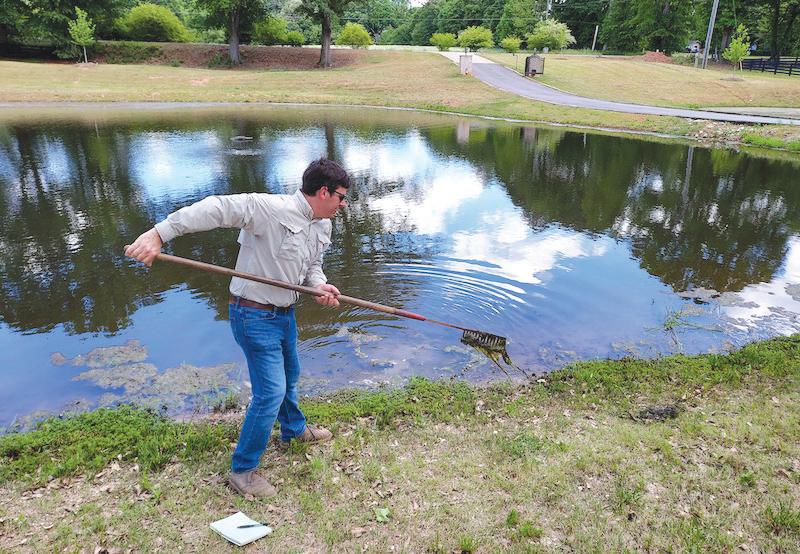
Buffers help slow and filter stormwater with the presence of dense vegetation growth of tall grasses, shrubs and trees. Riparian buffers of 35- to 100-feet wide are recommended to reduce dissolved pollutants and eroded soils from entering waterways. The appropriate width depends on pollutant load, field slope, type and density of vegetation, soil structure, subsurface drainage patterns, and the frequency and force of storm events.
While riparian buffers are useful on waterfront properties, other landscapes can incorporate features that prevent stormwater from flowing toward storm drains and off the property. Grass swales, rain gardens, terraced slopes, permeable pavers and even proper mulching improve rain water infiltration into the soil and keep it from contributing to runoff pollution.
It’s also important to remember that what happens on the surface doesn’t always stay on the surface. Pollution from our land use activities can make its way into our groundwater resources that are important to millions of Georgia residents with drinking water wells. By designing an efficient landscape and fertilizer plan, you can save on maintenance costs while protecting water quality in your community.
WINTER 2023 | 57 URBAN AG
4 4 4 4 4 4 4 4 4 4 4 4


58 | Directory of advertisers WORKERS COMP INSURANCE EMPLOYEE BENEFITS PROPERTY AUTO Company/Website: ................. Page # Atlanta Best Media ................................ 23 atlantabestmedia.com Frank A Smith Nurseries ......................... 35 fasnurseries.com GA Certified Landscape Professional ....... 31 ugaurbanag.com/certification Greene County Fertilizer Company 55 greenecountyfert.com Howard Brothers ................................... 7 howardbrothers.com Legacy Turf Farms .................................. 59 legacyturffarms.com NG Turf ................................................... 3 ngturf.com Power Equipment Distributors ................ 2 powereqp.com Progressive Turf Equipment .................... 45 progressiveturfequip.com Proven Winners 11 provenwinners-shrubs.com Snellings Walters ................................... 37 snellingswalters.com Sunbelt Turf ........................................... 33 sunbeltturffarms.com Super-Sod ............................................. 60 supersod.com Synkd Live ............................................ 41 synkd.io/live-event
Crushes the Cold
Developed by Oklahoma State University
Tahoma 31® Bermudagrass is among the most winter-hardy of the improved hybrid bermudagrasses on the market today! Developed by Oklahoma State University (as OKC 1131) in response to a growing demand for the next generation of winter-hardy varieties, Tahoma 31 derives its name from the Native American word, Tahoma, which means frozen water. With the additional characteristics of both improved wear tolerance and drought resistance, Tahoma 31 is ideally suited for sport turf, golf courses and high-quality lawns in the Mid-Atlantic & Transition Zone. Through nationwide testing in NTEP, Tahoma 31 excels in key metrics compared to other bermudagrasses including Tifway, TifTuf and Latitude 36.

COLD TOLERANT: Up to 75% more cold tolerant than Tifway, TifTuf & Latitude 36
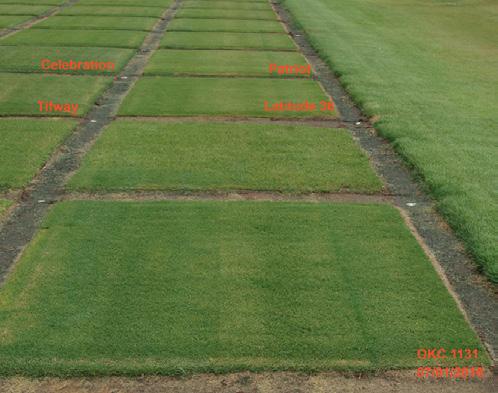
DROUGHT RESISTANT: 18% less water use than TifTuf
EARLY SPRING GREEN UP: Earlier than Tifway, TifTuf & Latitude 36
AVAILABLE NOW: Limited foundation planting material to licensed producers
UNIVERSITY APPROVED: Developed by top researchers at Oklahoma State University
LEGACY
TURF FARMS
850 Indian Mounds Road Cartersville, Georgia 30120 770-607-0491
sales@legacyturffarms.com

WINTER 2023 | 59

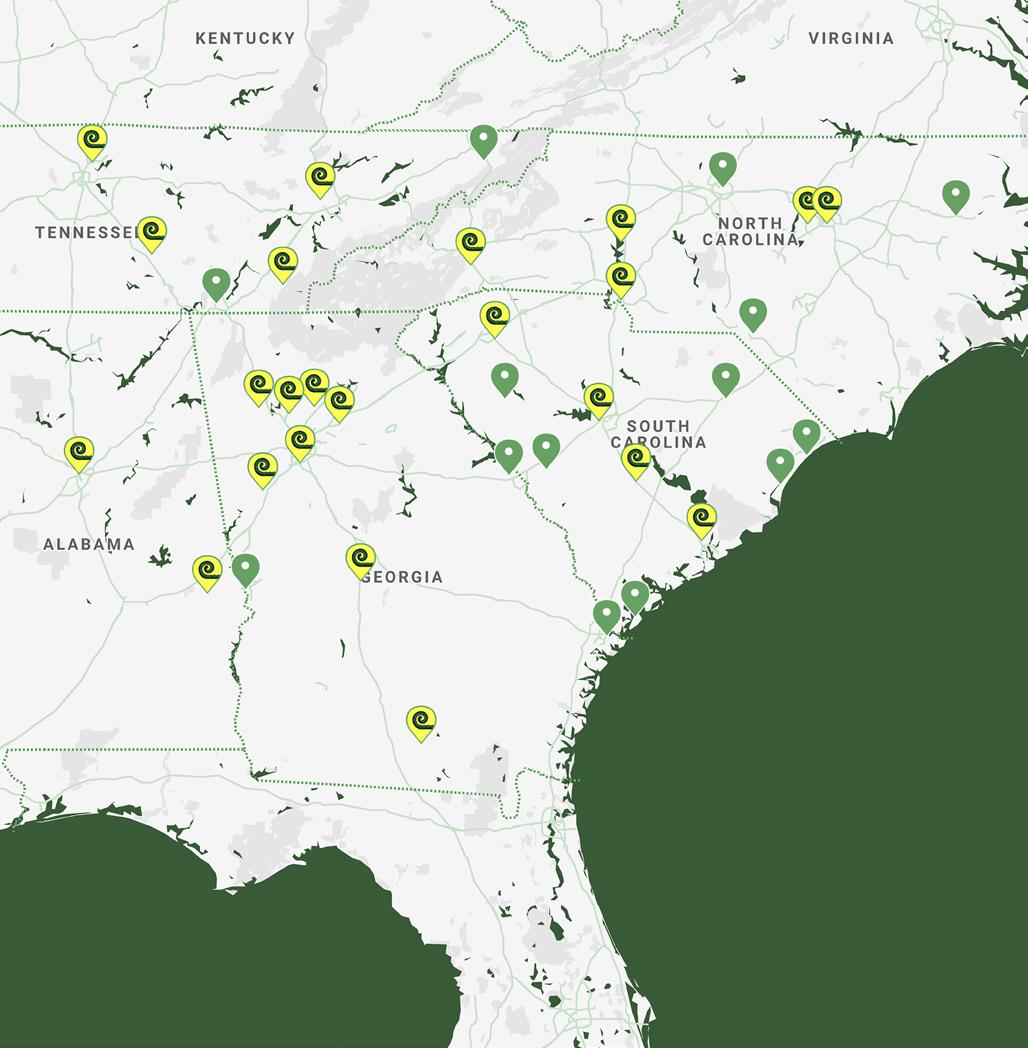


60 | UAC MAGAZINE ALPHARETTA 770-274-2262 CARTERSVILLE 770-382-7284 FOREST PARK 404-363-1932 FT. VALLEY 478-987-0776 LAWRENCEVILLE 770-277-7745 MARIETTA 770-516-3255 NEWNAN 888-360-1125 TifTuf® uses 38% less water than Tifway and will pay for itself in lower water bills. Maintains acceptable turf quality and aesthetics under drought stress. In Drought Tolerance
Zoysia sod is
textured, and easier to maintain than other fine-textured types.
• Get wholesale pricing • Choose pickup or delivery dates • Request expedited delivery • View your purchase history Get your Pro Account here GEORGIA WE’VE GOT YOU COVERED
Zeon®
dark green / mediumfine
Shade tolerant Zeon turfgrass is widely adaptable to full sun or moderate shade.














 | Executive Director
| Executive Director
































































































 by Bryan Tolar, Tolar Capitol Partners
by Bryan Tolar, Tolar Capitol Partners




















 Ball FloraPlant
Ball FloraPlant


































































